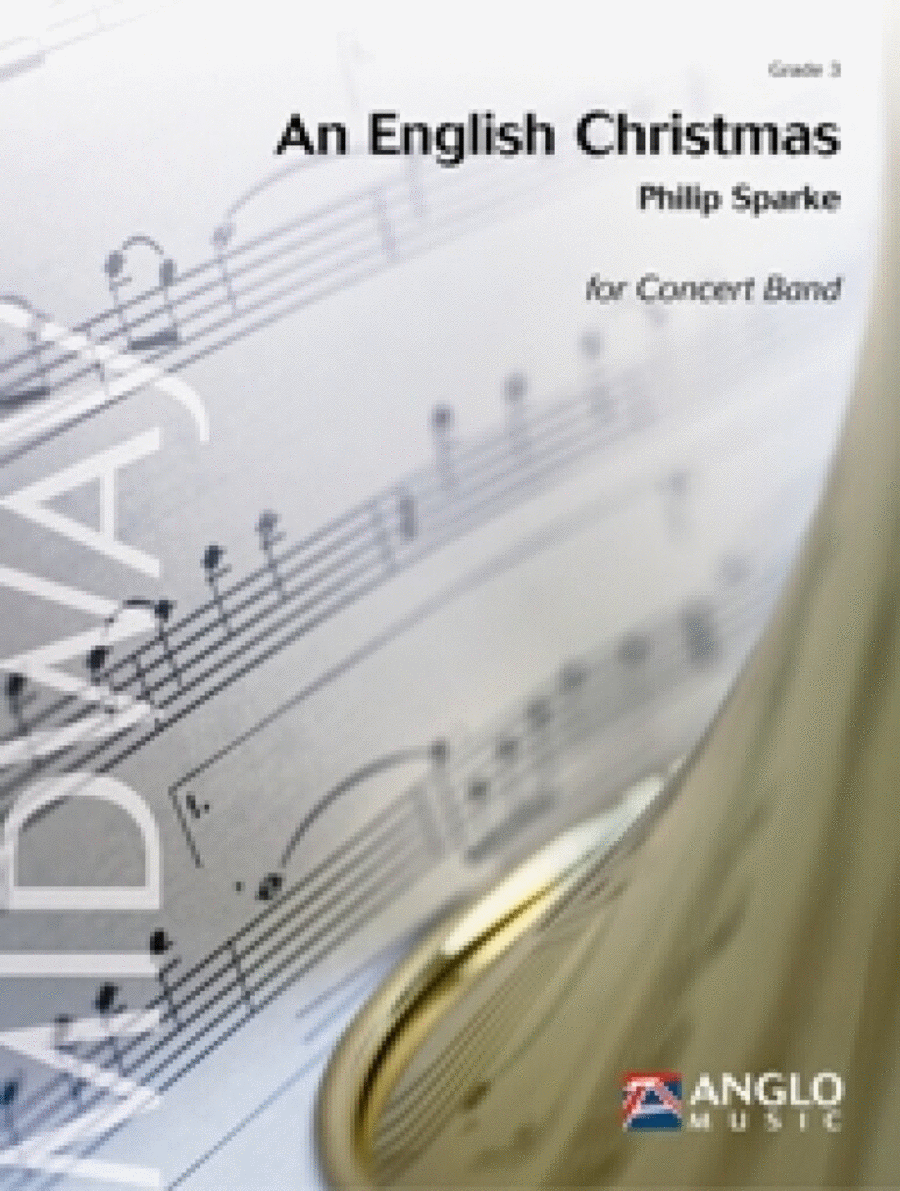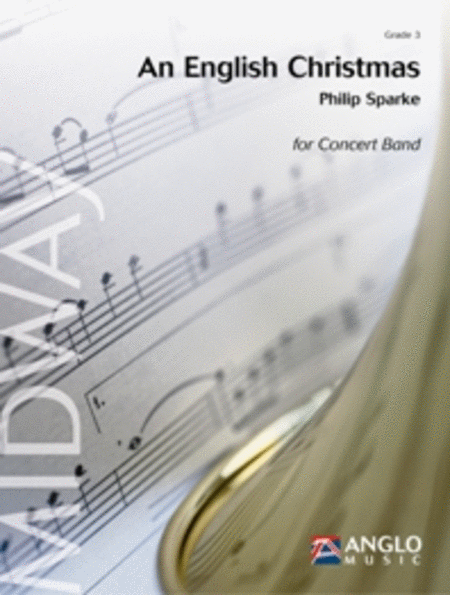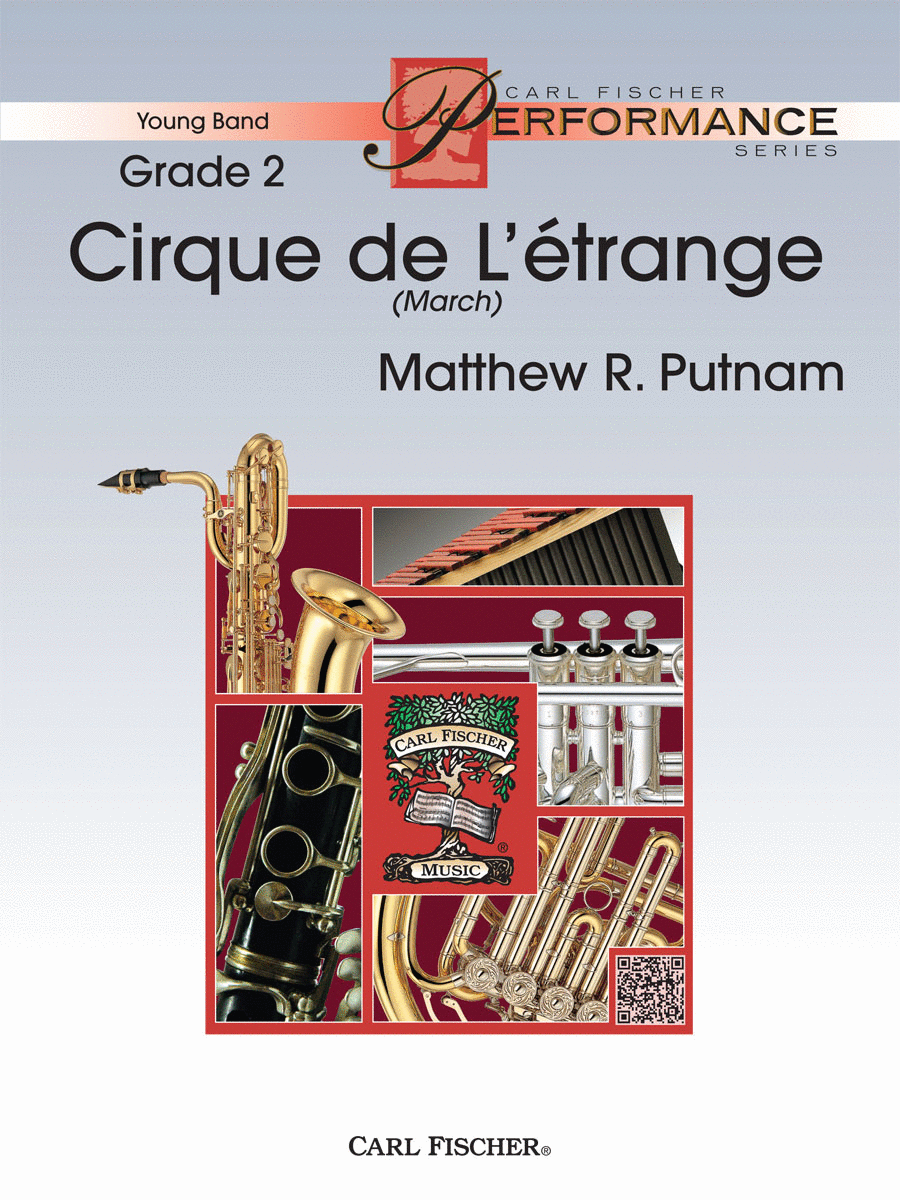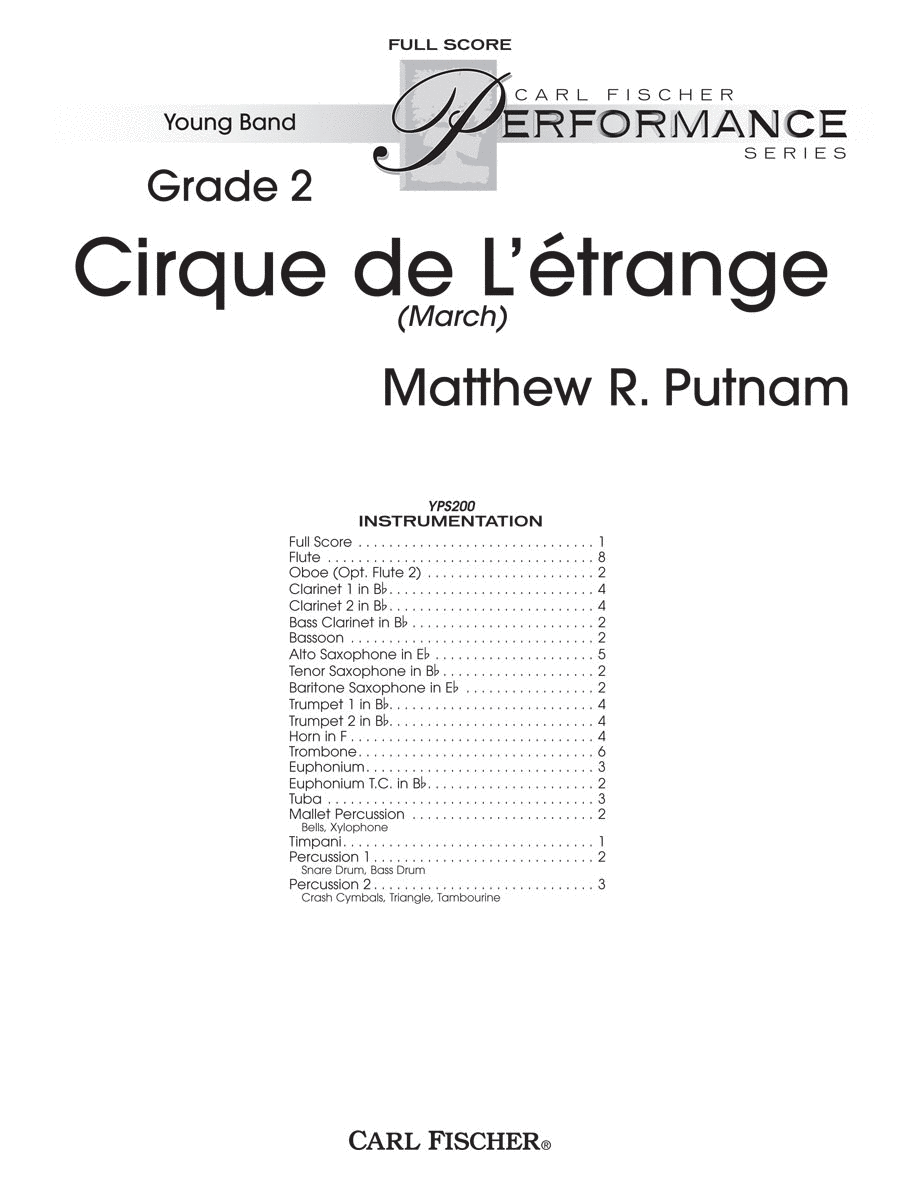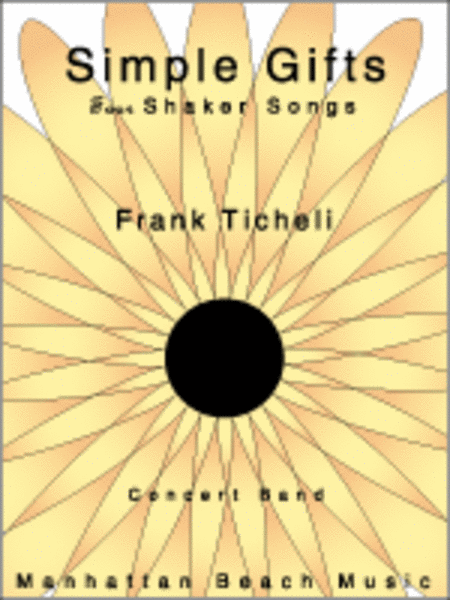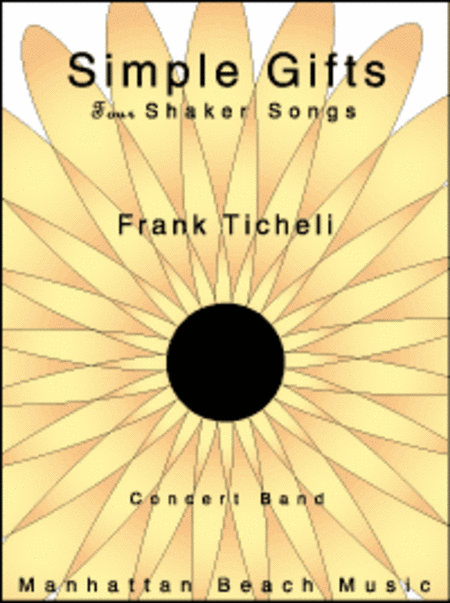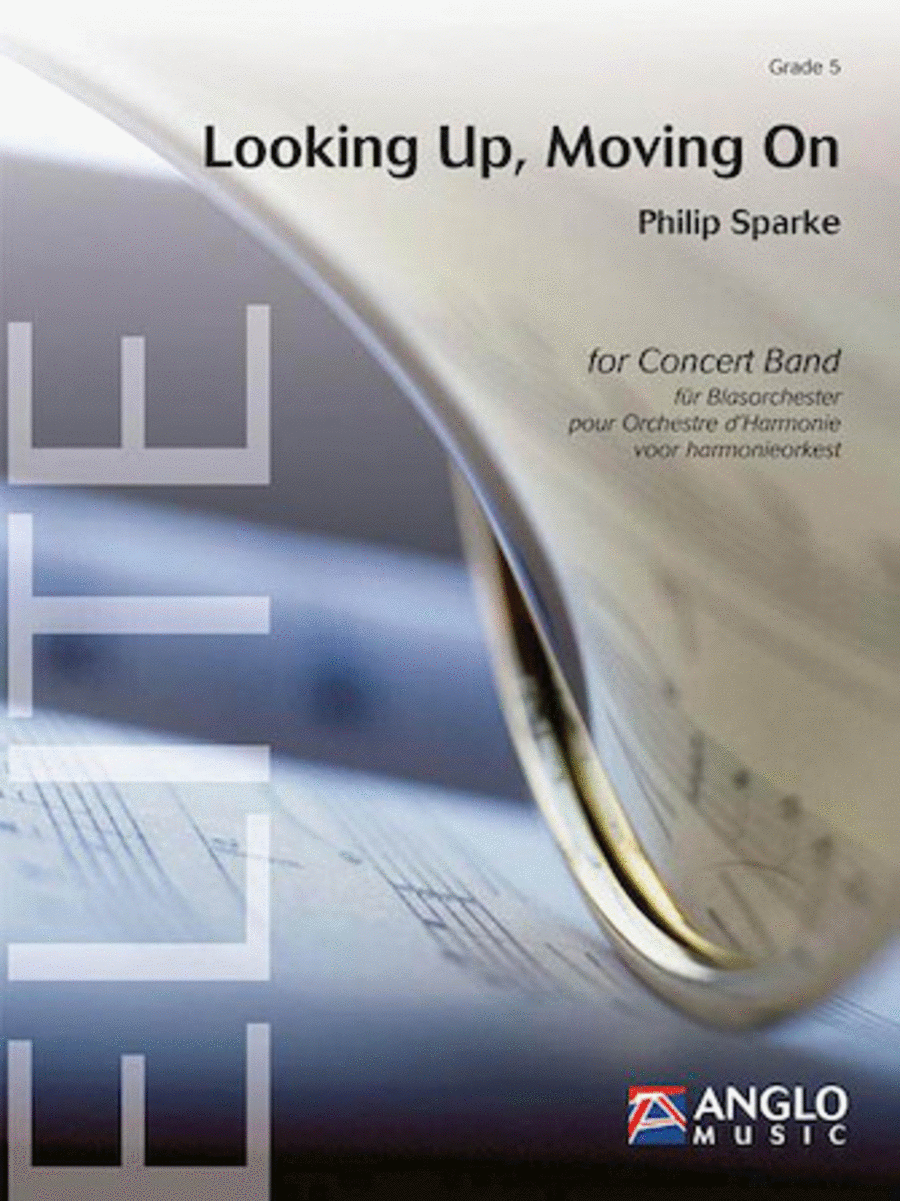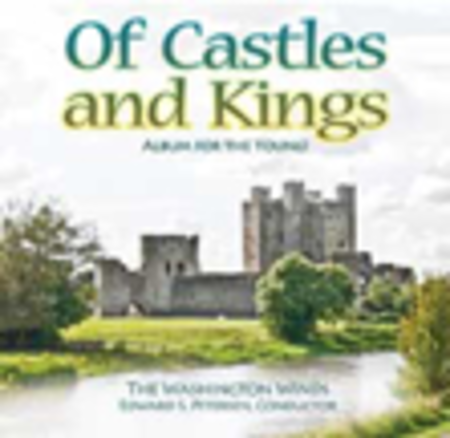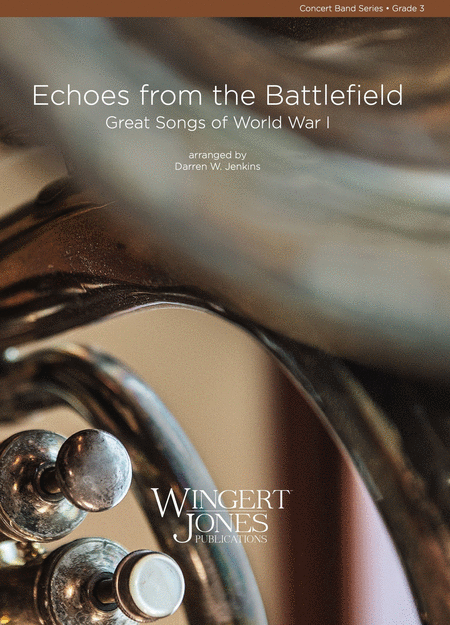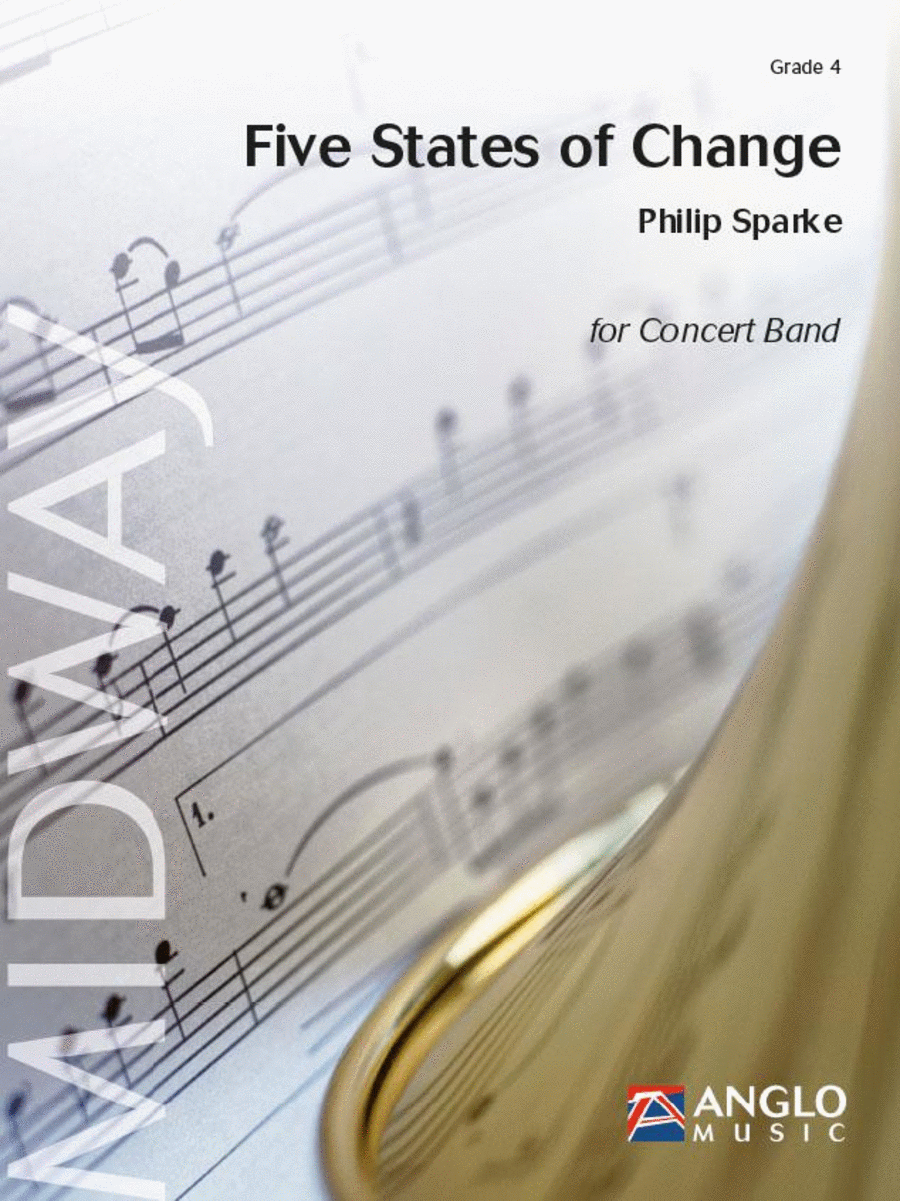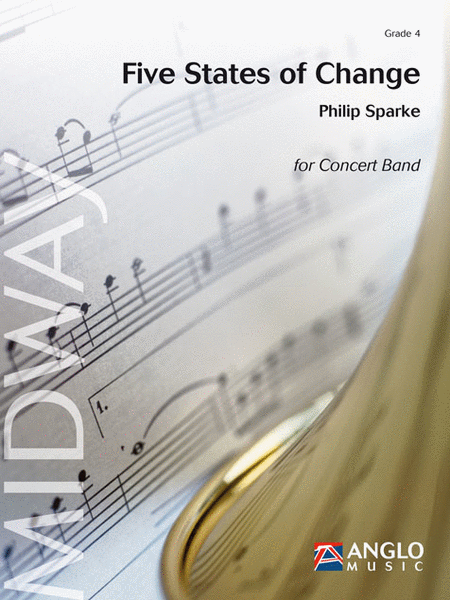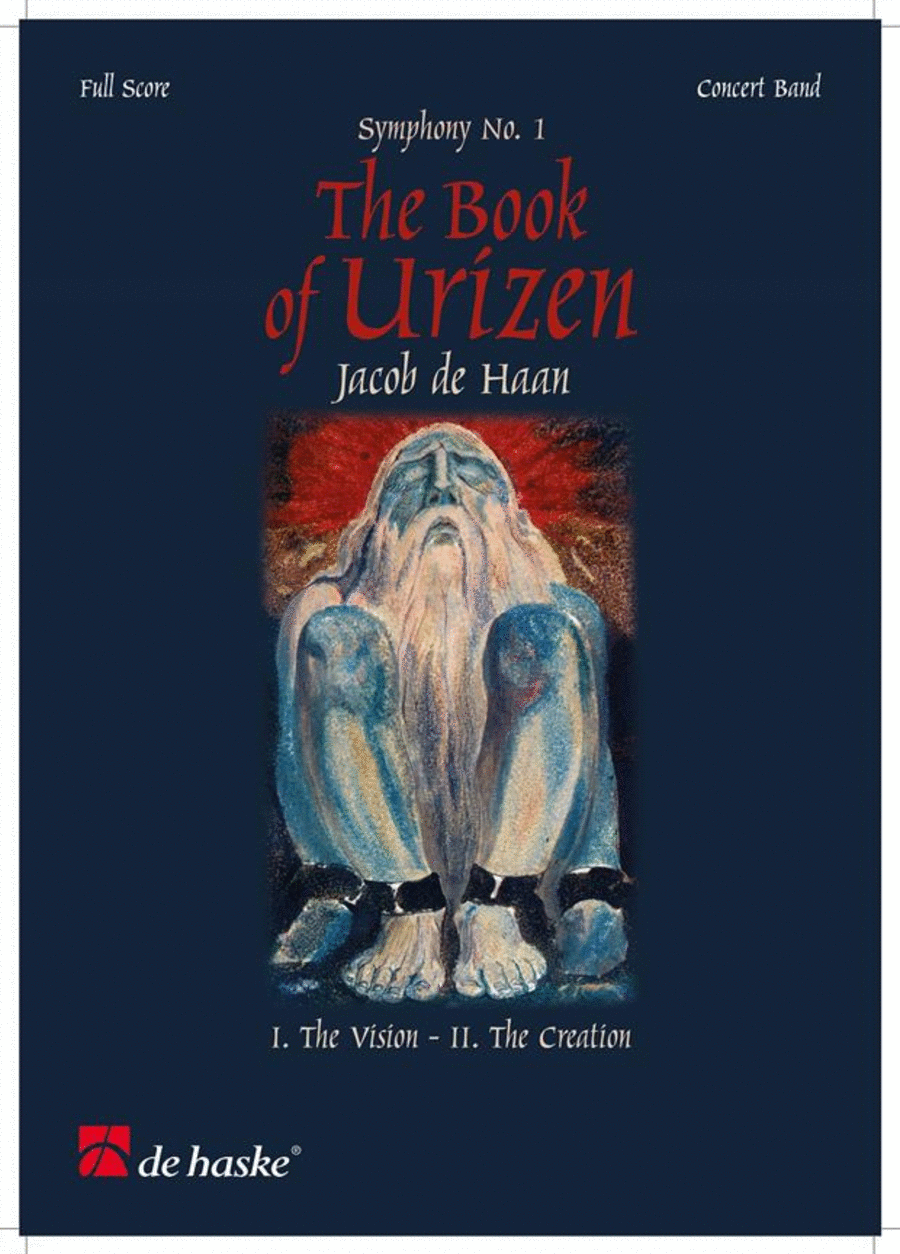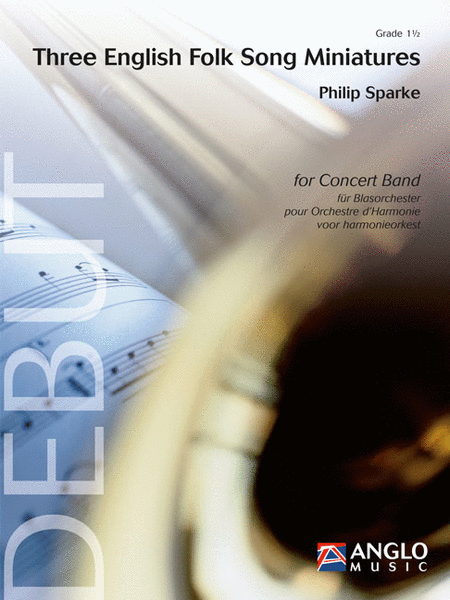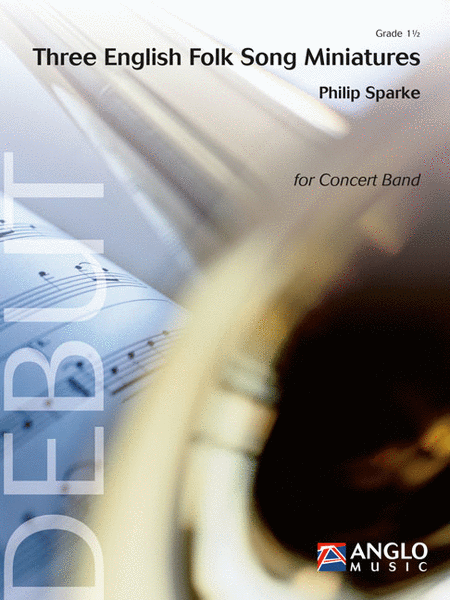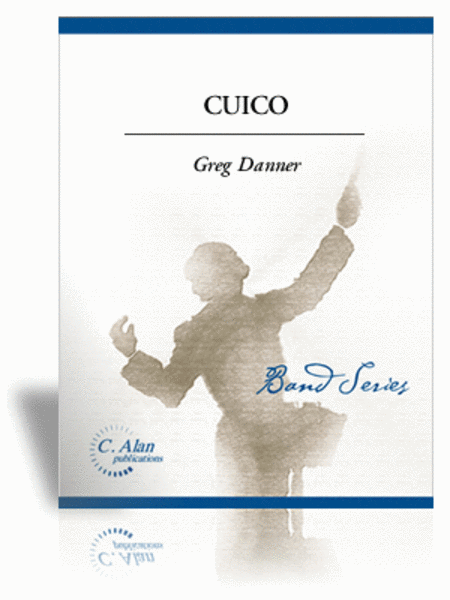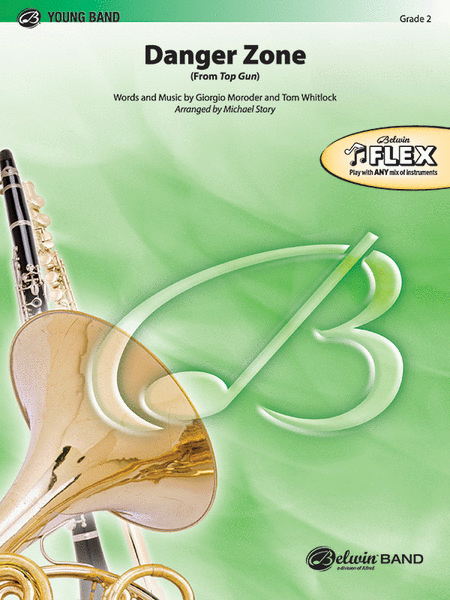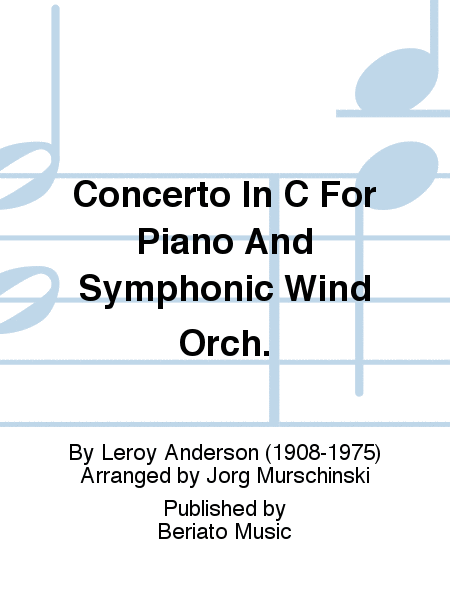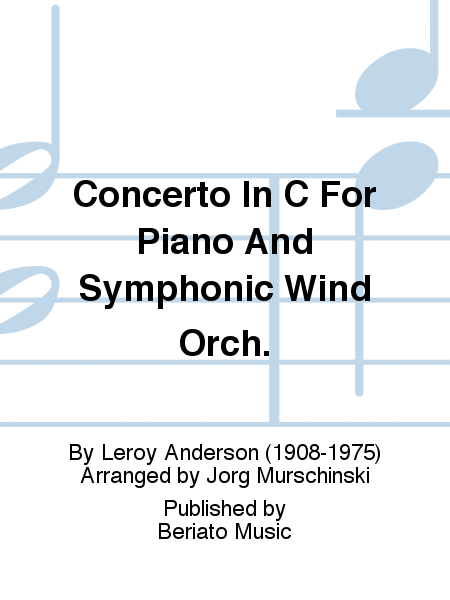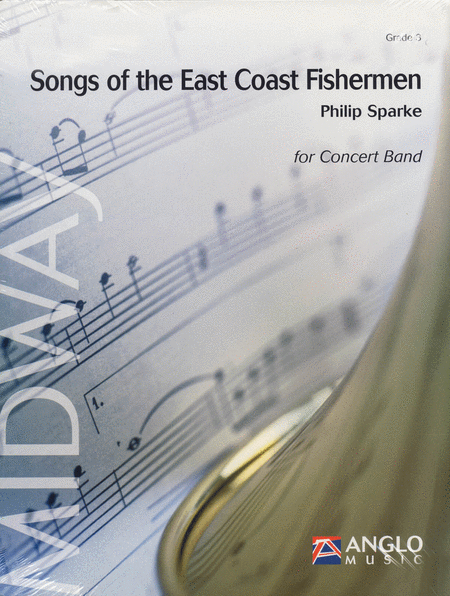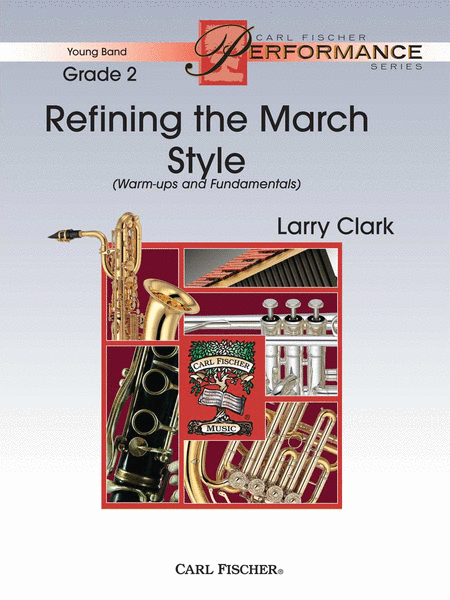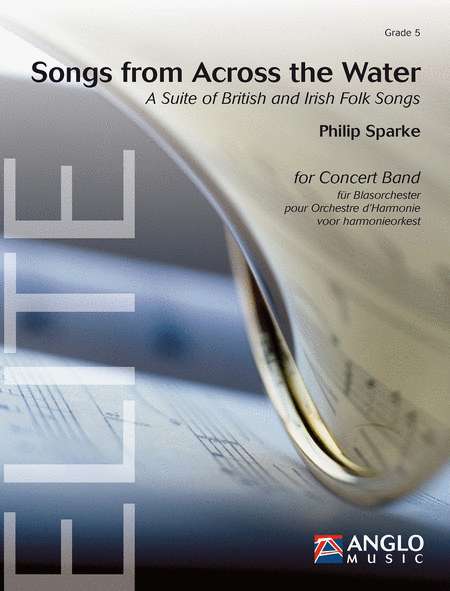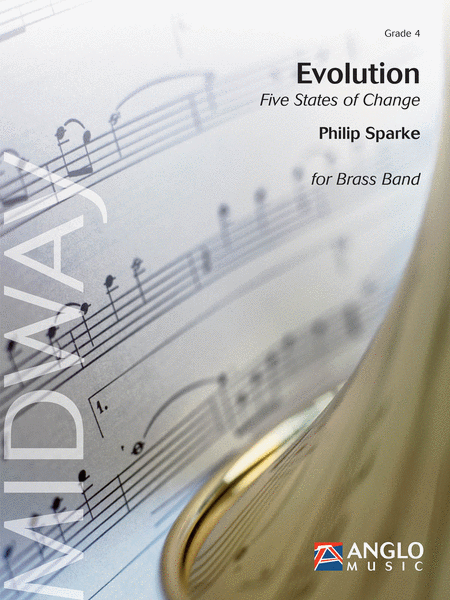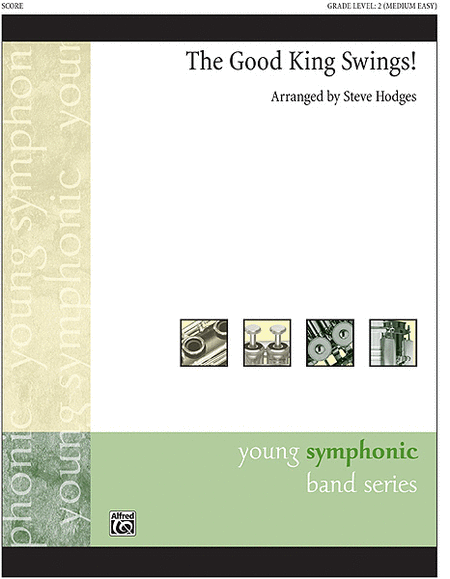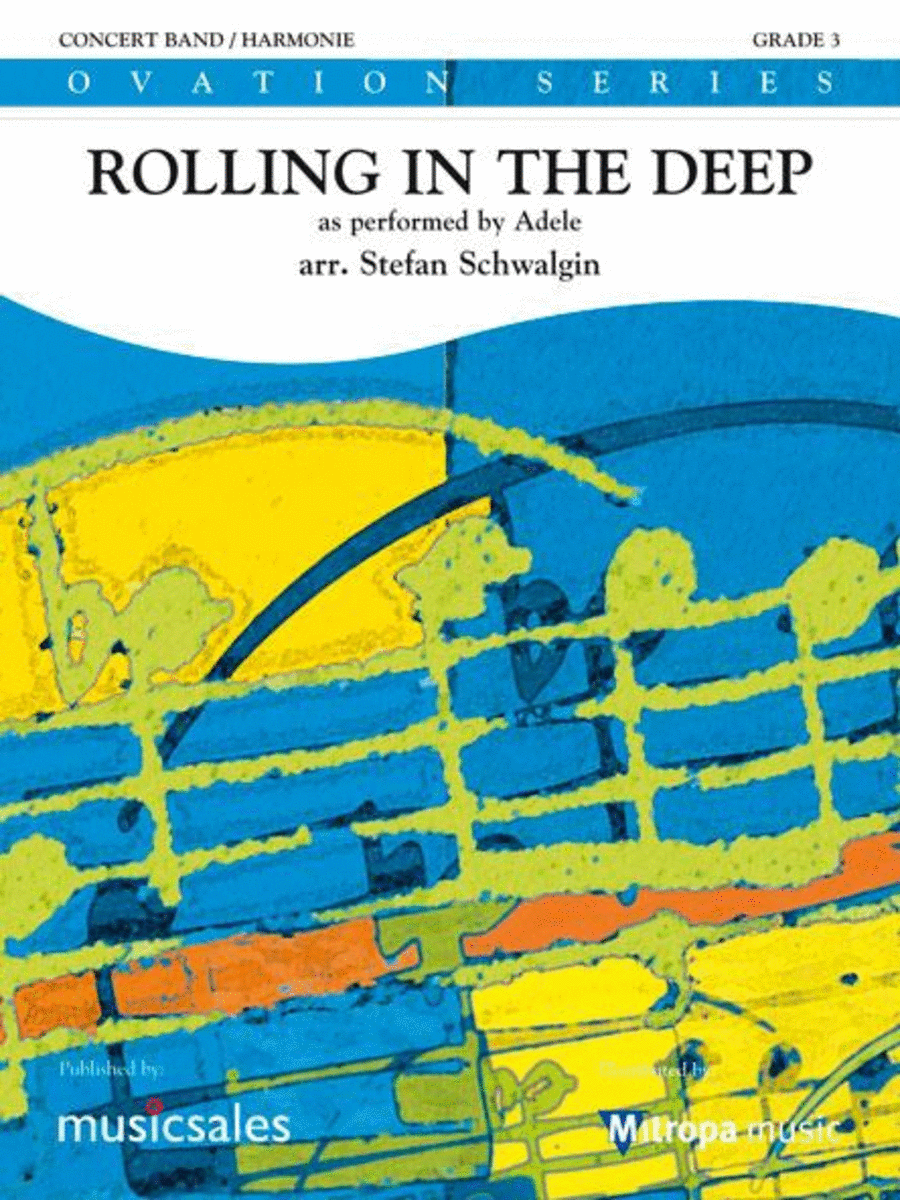|
| An English Christmas
Orchestre d'harmonie [Conducteur et Parties séparées] - Facile
Anglo Music
Concert Band/Harmonie - Grade 3 SKU: BT.AMP-225-010 Composed by Philip Sp...(+)
Concert Band/Harmonie -
Grade 3 SKU:
BT.AMP-225-010
Composed by Philip
Sparke. Anglo Music
Midway Series. Set (Score
& Parts). Composed 2007.
Anglo Music Press #AMP
225-010. Published by
Anglo Music Press
(BT.AMP-225-010). 9x12
inches.
English-German-French-Dut
ch. Christmas as
celebrated in England is
a relatively newtradition
dating from the time of
Queen Victoria.
Herhusband Prince Albert
was from Germany and he
broughtmany German
Christmas traditions with
him, including
theChristmas tree and
Christmascards, and even
carols such asHark, the
Herald Angels Sing.
Philip Sparke has however
useda varied selection of
English melodies to
arrange into his?Festival
of Carols?.The choir
parts are seperately
available (order no. AMP
227-050).
Hoewel
de Engelsen een lange
traditie kennen in het
zingen van carols zijn
veel van de melodieën
die er worden gezongen
afkomstig van het
Europese vasteland - of
uit Amerika. Desondanks
heeft Philip Sparke een
gevarieerde selectievan
Engelse melodieën
kunnen samenstellen voor
dit prachtige
‘Festival of
Carols’ - dat
zowel met als zonder koor
kan worden
uitgevoerd.
Weihna
chten, wie es heute in
England gefeiert wird,
ist eine relativ junge
Tradition aus dem 19,
Jahrhundert, die der
deutsche Ehemann von
Königin Victoria mit
in seine neue Heimat
brachte. Viele
gebräuchliche
Weihnachtslieder stammen
ebenfalls nichtaus
England. Philip Sparke
gelang es jedoch, eine
abwechslungsreiche
Sammlung von Liedern aus
seiner Heimat zu diesem
schönen englischen
Weihnachtslieder-Festival
“ zu formen.Die
optional einsetzbaren
Chorstimmen sind unter
der Artikelnummer
AMP227-050 separat
erhältlich.
« La plupart
des traditions de Noël
en Angleterre sont
relativement récentes.
Montée sur le trône
en 1837, la reine
Victoria (née de
Hanovre) régnera
jusqu’ sa mort en
1901. En 1840, elle
épousa son cousin, le
prince Albert de
Saxe-Cobourg-Gotha.
Leprince consort,
originaire
d’Allemagne,
importa bon nombre de
traditions de Noël
allemandes au
Royaume-Uni. Ainsi, il
fit découvrir aux
Anglais la coutume du
sapin et les cartes de
Noël, entre autres,
contribuant largement au
Noël typiquement
anglaistel que nous le
connaissons
aujourd’hui.Bien
que les chants de Noël
font l’objet
d’une longue
tradition en Angleterre,
de nombreuses mélodies
que nous chantons
proviennent ducontinent
européen ou des
États-Unis. Je savais
bien que le
célébrissimeSile
nt Night (Douce nuit)
était d’origine
autrichienne et que
Hark, the Herald
Angels Sing (Écoutez
le chant des Anges)
était d’origine
allemande. Pourtant,
quelle ne fut pas ma
surprise
d’apprendre
qu’Away in a
Manger (Sur la
paillefraîche) ou
encore We Three
Kings nous venaient
des États-Unis et que
Ding, Dong Merrily on
High était un
noël d’origine
française.
Quoiqu’il en soit,
j’ai réussi
constituer un canevas de
mélodies anglaises
pour réaliser
cefestival de chants de
Noël. »Philip
SparkeRemarques sur
l’interprétatio
n : Cet arrangement est
adapté pour une
interprétation avec ou
sans Chœur.
S’il est joué
par un Orchestre
d’Harmonie seul,
les parties vocales
seront doublées par
des
partiesinstrumentales.Les
tempi indiqués
correspondent une
interprétation par un
Orchestre
d’Harmonie seul.
Si l’œuvre
est donnée avec un
Chœur, il est sans
doute nécessaire de
baisser le tempo en
fonction du nombre de
choristes et
del’acoustique du
lieu de concert.Les
parties de Chœur (en
anglais) sont disponibles
séparément (Réf.
: AMP 227-050). $145.95 - Voir plus => AcheterDélais: 2 to 3 weeks | | | |
| An English Christmas Brass Band Set Score And Parts
Orchestre d'harmonie - Facile
Anglo Music
Brass Band (Score & Parts) - Grade 3 SKU: HL.44012730 Composed by Philip ...(+)
Brass Band (Score &
Parts) - Grade 3 SKU:
HL.44012730 Composed
by Philip Sparke. Anglo
Music Concert Band.
Concert Piece. Softcover.
Composed 2007. Anglo
Music Press #AMP225030.
Published by Anglo Music
Press (HL.44012730).
9x12 inches.
English-German-French-Dut
ch. Christmas as
celebrated in England is
a relatively newtradition
dating from the time of
Queen Victoria.
Herhusband Prince Albert
was from Germany and he
broughtmany German
Christmas traditions with
him, including
theChristmas tree and
Christmascards, and even
carols such asHark, the
Herald Angels Sing.
Philip Sparke has however
useda varied selection of
English melodies to
arrange into his?Festival
of Carols?.The choir
parts are seperately
available (order no. AMP
227-050). Christmas as
celebrated in England is
a relatively new
tradition dating from the
time of Queen Victoria.
Her husband Prince Albert
was from Germany and he
brought many German
Christmas traditions with
him, including the
Christmas tree and
Christmas cards, and even
carols such as Hark, the
Herald Angels Sing.
Philip
Sparke has
however used a varied
selection of English
melodies to arrange into
his Festival of
Carols. The choir
parts are seperately
available (order no. AMP
227-050).
Hoewel
de Engelsen een lange
traditie kennen in het
zingen van carols zijn
veel van de melodieen die
er worden gezongen
afkomstig van het
Europese vasteland - of
uit Amerika. Desondanks
heeft Philip Sparke een
gevarieerde selectievan
Engelse melodieen kunnen
samenstellen voor dit
prachtige 'Festival of
Carols' - dat zowel met
als zonder koor kan
worden
uitgevoerd.
Weihna
chten, wie es heute in
England gefeiert wird,
ist eine relativ junge
Tradition aus dem 19,
Jahrhundert, die der
deutsche Ehemann von
Konigin Victoria mit in
seine neue Heimat
brachte. Viele
gebrauchliche
Weihnachtslieder stammen
ebenfalls nichtaus
England. Philip Sparke
gelang es jedoch, eine
abwechslungsreiche
Sammlung von Liedern aus
seiner Heimat zu diesem
schonen englischen
Weihnachtslieder-Festival
zu formen.Die optional
einsetzbaren Chorstimmen
sind unter der
Artikelnummer
AMP227-050 separat
erhaltlich.
<< La
plupart des traditions de
Noel en Angleterre sont
relativement recentes.
Montee sur le trone en
1837, la reine Victoria
(nee de Hanovre) regnera
jusqu'a sa mort en 1901.
En 1840, elle epousa son
cousin, le prince Albert
de Saxe-Cobourg-Gotha.
Leprince consort,
originaire d'Allemagne,
importa bon nombre de
traditions de Noel
allemandes au
Royaume-Uni. Ainsi, il
fit decouvrir aux Anglais
la coutume du sapin et
les cartes de Noel, entre
autres, contribuant
largement au Noel
typiquement anglaistel
que nous le connaissons
aujourd'hui.Bien que les
chants de Noel font
l'objet d'une longue
tradition en Angleterre,
de nombreuses melodies
que nous chantons
proviennent ducontinent
europeen ou des
Etats-Unis. Je savais
bien que le
celebrissimeSilent
Night (Douce nuit)
etait d'origine
autrichienne et que
Hark, the Herald
Angels Sing (Ecoutez le
chant des Anges)
etait d'origine
allemande. Pourtant,
quelle ne fut pas ma
surprise d'apprendre
qu'Away in a Manger
(Sur la
paillefraiche) ou
encore We Three
Kings nous venaient
des Etats-Unis et que
Ding, Dong Merrily on
High etait un noel
d'origine francaise.
Quoiqu'il en soit, j'ai
reussi a constituer un
canevas de melodies
anglaises pour realiser
cefestival de chants de
Noel. >>Philip
SparkeRemarques sur
l'interpretation : Cet
arrangement est adapte
pour une interpretation
avec ou sans Chœur.
S'il est joue par un
Brass Band, les parties
vocales seront doublees
par des
partiesinstrumentales.Les
tempi indiques
correspondent a une
interpretation par un
Brass Band seul. Si
l'œuvre est donnee
avec un Chœur, il
est sans doute necessaire
de baisser le tempo en
fonction du nombre de
choristes et de
l'acoustique du lieude
concert.Les parties de
Chœur (en anglais)
sont disponibles
separement (Ref. : AMP
227-050).
The
choir parts are
seperately available
(order no. AMP
227-050). $94.00 - Voir plus => AcheterDélais: 2 to 3 weeks | | | |
| An English Christmas
Orchestre d'harmonie [Conducteur] - Facile
Anglo Music
Concert Band/Harmonie - Grade 3 SKU: BT.AMP-225-140 Composed by Philip Sp...(+)
Concert Band/Harmonie -
Grade 3 SKU:
BT.AMP-225-140
Composed by Philip
Sparke. Anglo Music
Midway Series. Concert
Piece. Score Only.
Composed 2007. 44 pages.
Anglo Music Press #AMP
225-140. Published by
Anglo Music Press
(BT.AMP-225-140). 9x12
inches.
English-German-French-Dut
ch. The choir parts
are seperately available
(order no. AMP 227-050).
Hoewel de
Engelsen een lange
traditie kennen in het
zingen van carols zijn
veel van de melodieën
die er worden gezongen
afkomstig van het
Europese vasteland - of
uit Amerika. Desondanks
heeft Philip Sparke een
gevarieerde selectievan
Engelse melodieën
kunnen samenstellen voor
dit prachtige
‘Festival of
Carols’ - dat
zowel met als zonder koor
kan worden
uitgevoerd.
Weihna
chten, wie es heute in
England gefeiert wird,
ist eine relativ junge
Tradition aus dem 19,
Jahrhundert, die der
deutsche Ehemann von
Königin Victoria mit
in seine neue Heimat
brachte. Viele
gebräuchliche
Weihnachtslieder stammen
ebenfalls nichtaus
England. Philip Sparke
gelang es jedoch, eine
abwechslungsreiche
Sammlung von Liedern aus
seiner Heimat zu diesem
schönen englischen
Weihnachtslieder-Festival
“ zu formen.Die
optional einsetzbaren
Chorstimmen sind unter
der Artikelnummer
AMP227-050 separat
erhältlich.
« La plupart
des traditions de Noël
en Angleterre sont
relativement récentes.
Montée sur le trône
en 1837, la reine
Victoria (née de
Hanovre) régnera
jusqu’ sa mort en
1901. En 1840, elle
épousa son cousin, le
prince Albert de
Saxe-Cobourg-Gotha.
Leprince consort,
originaire
d’Allemagne,
importa bon nombre de
traditions de Noël
allemandes au
Royaume-Uni. Ainsi, il
fit découvrir aux
Anglais la coutume du
sapin et les cartes de
Noël, entre autres,
contribuant largement au
Noël typiquement
anglaistel que nous le
connaissons
aujourd’hui.Bien
que les chants de Noël
font l’objet
d’une longue
tradition en Angleterre,
de nombreuses mélodies
que nous chantons
proviennent ducontinent
européen ou des
États-Unis. Je savais
bien que le
célébrissimeSile
nt Night (Douce nuit)
était d’origine
autrichienne et que
Hark, the Herald
Angels Sing (Écoutez
le chant des Anges)
était d’origine
allemande. Pourtant,
quelle ne fut pas ma
surprise
d’apprendre
qu’Away in a
Manger (Sur la
paillefraîche) ou
encore We Three
Kings nous venaient
des États-Unis et que
Ding, Dong Merrily on
High était un
noël d’origine
française.
Quoiqu’il en soit,
j’ai réussi
constituer un canevas de
mélodies anglaises
pour réaliser
cefestival de chants de
Noël. »Philip
SparkeRemarques sur
l’interprétatio
n : Cet arrangement est
adapté pour une
interprétation avec ou
sans Chœur.
S’il est joué
par un Orchestre
d’Harmonie seul,
les parties vocales
seront doublées par
des
partiesinstrumentales.Les
tempi indiqués
correspondent une
interprétation par un
Orchestre
d’Harmonie seul.
Si l’œuvre
est donnée avec un
Chœur, il est sans
doute nécessaire de
baisser le tempo en
fonction du nombre de
choristes et
del’acoustique du
lieu de concert.Les
parties de Chœur (en
anglais) sont disponibles
séparément (Réf.
: AMP 227-050). $28.95 - Voir plus => AcheterDélais: 2 to 3 weeks | | | |
| An English Christmas Brass Band Score
Orchestre d'harmonie - Facile
Anglo Music
Brass Band (Full Score) - Grade 3 SKU: HL.44012731 Composed by Philip Spa...(+)
Brass Band (Full Score) -
Grade 3 SKU:
HL.44012731 Composed
by Philip Sparke. Anglo
Music Concert Band.
Concert Piece. Softcover.
Composed 2007. Anglo
Music Press #AMP225130.
Published by Anglo Music
Press (HL.44012731).
9x12 inches.
English-German-French-Dut
ch. The choir parts
are seperately available
(order no. AMP 227-050).
Hoewel de
Engelsen een lange
traditie kennen in het
zingen van carols zijn
veel van de melodieen die
er worden gezongen
afkomstig van het
Europese vasteland - of
uit Amerika. Desondanks
heeft Philip Sparke een
gevarieerde selectievan
Engelse melodieen kunnen
samenstellen voor dit
prachtige 'Festival of
Carols' - dat zowel met
als zonder koor kan
worden
uitgevoerd.
Weihna
chten, wie es heute in
England gefeiert wird,
ist eine relativ junge
Tradition aus dem 19,
Jahrhundert, die der
deutsche Ehemann von
Konigin Victoria mit in
seine neue Heimat
brachte. Viele
gebrauchliche
Weihnachtslieder stammen
ebenfalls nichtaus
England. Philip Sparke
gelang es jedoch, eine
abwechslungsreiche
Sammlung von Liedern aus
seiner Heimat zu diesem
schonen englischen
Weihnachtslieder-Festival
zu formen.Die optional
einsetzbaren Chorstimmen
sind unter der
Artikelnummer
AMP227-050 separat
erhaltlich.
<< La
plupart des traditions de
Noel en Angleterre sont
relativement recentes.
Montee sur le trone en
1837, la reine Victoria
(nee de Hanovre) regnera
jusqu'a sa mort en 1901.
En 1840, elle epousa son
cousin, le prince Albert
de Saxe-Cobourg-Gotha.
Leprince consort,
originaire d'Allemagne,
importa bon nombre de
traditions de Noel
allemandes au
Royaume-Uni. Ainsi, il
fit decouvrir aux Anglais
la coutume du sapin et
les cartes de Noel, entre
autres, contribuant
largement au Noel
typiquement anglaistel
que nous le connaissons
aujourd'hui.Bien que les
chants de Noel font
l'objet d'une longue
tradition en Angleterre,
de nombreuses melodies
que nous chantons
proviennent ducontinent
europeen ou des
Etats-Unis. Je savais
bien que le
celebrissimeSilent
Night (Douce nuit)
etait d'origine
autrichienne et que
Hark, the Herald
Angels Sing (Ecoutez le
chant des Anges)
etait d'origine
allemande. Pourtant,
quelle ne fut pas ma
surprise d'apprendre
qu'Away in a Manger
(Sur la
paillefraiche) ou
encore We Three
Kings nous venaient
des Etats-Unis et que
Ding, Dong Merrily on
High etait un noel
d'origine francaise.
Quoiqu'il en soit, j'ai
reussi a constituer un
canevas de melodies
anglaises pour realiser
cefestival de chants de
Noel. >>Philip
SparkeRemarques sur
l'interpretation : Cet
arrangement est adapte
pour une interpretation
avec ou sans Chœur.
S'il est joue par un
Brass Band, les parties
vocales seront doublees
par des
partiesinstrumentales.Les
tempi indiques
correspondent a une
interpretation par un
Brass Band seul. Si
l'œuvre est donnee
avec un Chœur, il
est sans doute necessaire
de baisser le tempo en
fonction du nombre de
choristes et de
l'acoustique du lieude
concert.Les parties de
Chœur (en anglais)
sont disponibles
separement (Ref. : AMP
227-050). $28.99 - Voir plus => AcheterDélais: 2 to 3 weeks | | | |
| Cirque de L’étrange
Orchestre d'harmonie - Facile
Carl Fischer
Band Concert Band - Grade 2 SKU: CF.YPS200 Composed by Matthew R. Putnam....(+)
Band Concert Band - Grade
2 SKU: CF.YPS200
Composed by Matthew R.
Putnam. Young Band (YPS).
Set of Score and Parts.
With Standard notation.
8+2+4+2+2+5+2+2+4+4+6+3+3
+2+1+3+16+4+4+2+2 pages.
Duration 2:15. Carl
Fischer Music #YPS200.
Published by Carl Fischer
Music (CF.YPS200).
ISBN 9781491152201.
UPC: 680160909704. Key: D
minor. Step right
up, ladies and gentleman,
boys and girls, step
right up! See the exotic,
the strange, and the
magical at the Cirque de
L’étrange, or
“Circus of the
Strange.†This
piece evokes a bygone era
when circuses and
carnivals provided people
from all walks of life a
chance to see human and
animal
oddities. Cirque de
L'étrange is an
original concert march
written in standard march
form, but its sound is
anything but standard.
This piece is playable by
younger groups and is a
great way to expose
students to the march
form and style without
sounding like your
typical march.
Step
right up ladies and
gentleman, boys and
girls, step right up! See
the exotic, the strange,
and the magical at the
Cirque de
L’étrange.
Welcome to the Cirque de
L’étrange,
known in English as the
“Circus of the
Strange.†This
piece evokes a time of a
bygone era, a time when
circuses and carnivals
provided people from all
walks of life a chance to
see human and animal
oddities that were
sources of both delight
and horror. While many of
these sideshow
attractions were deemed
fraudulent, it did not
deter the crowds from
flocking to be shocked
and awed. I have always
held a special place in
my heart for the
showmanship of carnivals,
because my grandfather
dearly loved them. For
much of his life, he
worked at fairs and
carnivals selling cotton
candy and candy apples. A
large portion of my days
when growing up were
spent running around
fairgrounds and helping
my grandfather with his
stand. He imparted in me
a love for the cunning,
magic, and sheer joy that
only carnivals and
circuses can bring. In
Cirque de
L’étrange, I
sought to capture the the
mirthful, yet uncanny
mood of the carnivals
that I grew up exploring,
thus transporting you to
a different time.Cirque
de L'étrange is an
original concert march
written in standard march
form, but its sound is
anything but standard.
This piece is playable by
younger groups, as it is
a great way to expose
students to the march
form and style while not
sounding like your
typical march.Opening in
D minor, the piece
combines the playful feel
of a march and a macabre
tango. The second time
through the First Strain
(mm. 5-23), the upper
woodwinds and bells add a
second counter melody
based in D harmonic
minor, which heightens
the peculiar nature of
the piece. The Second
Strain (mm. 24-43) by
contrast, is a little
more upbeat, thus evoking
the magical ebullience of
a circus, which is
further highlighted by
the xylophone part. The
Second Strain ends in the
key of F major and sets
up the transition to the
Trio in the key of G
minor. The Trio (m. 44)
begins with the G
harmonic minor melody in
the clarinets and a
counter melody in the
bassoon and tenor
saxophone. The rest of
the woodwinds and bells
join in at m. 60 while
the percussion adds a
Gypsy-like feel with
tambourine and triangle.
At m. 76 the full band
joins in the macabre
parade with the trombones
and baritones harmonizing
the counter melody. The
conclusion of the march
has the upper woodwinds,
adding a second counter
melody complete with
trills to bring the march
to an exciting and
dramatic finish.As the
World’s Greatest
Showman, P.T. Barnum, a
man my grandfather
greatly admired, once
said “The noblest
art is that of making
others happy.†It
is my hope that through
this piece you will
experience the thrill,
delight, and fright that
only carnivals can bring
as you visit the Circus
of the Strange! $70.00 - Voir plus => AcheterDélais: 1 to 2 weeks | | | |
| Cirque de L’étrange
Orchestre d'harmonie [Conducteur] - Facile
Carl Fischer
Band Concert Band - Grade 2 SKU: CF.YPS200F Composed by Matthew R. Putnam...(+)
Band Concert Band - Grade
2 SKU: CF.YPS200F
Composed by Matthew R.
Putnam. Young Band (YPS).
Full score. With Standard
notation. 16 pages. Carl
Fischer Music #YPS200F.
Published by Carl Fischer
Music (CF.YPS200F).
ISBN 9781491152881.
UPC:
680160910380. Step
right up, ladies and
gentleman, boys and
girls, step right up! See
the exotic, the strange,
and the magical at the
Cirque de
L’étrange, or
“Circus of the
Strange.†This
piece evokes a bygone era
when circuses and
carnivals provided people
from all walks of life a
chance to see human and
animal
oddities. Cirque de
L'étrange is an
original concert march
written in standard march
form, but its sound is
anything but standard.
This piece is playable by
younger groups and is a
great way to expose
students to the march
form and style without
sounding like your
typical march.
Step
right up ladies and
gentleman, boys and
girls, step right up! See
the exotic, the strange,
and the magical at the
Cirque de
L’étrange.
Welcome to the Cirque de
L’étrange,
known in English as the
“Circus of the
Strange.†This
piece evokes a time of a
bygone era, a time when
circuses and carnivals
provided people from all
walks of life a chance to
see human and animal
oddities that were
sources of both delight
and horror. While many of
these sideshow
attractions were deemed
fraudulent, it did not
deter the crowds from
flocking to be shocked
and awed. I have always
held a special place in
my heart for the
showmanship of carnivals,
because my grandfather
dearly loved them. For
much of his life, he
worked at fairs and
carnivals selling cotton
candy and candy apples. A
large portion of my days
when growing up were
spent running around
fairgrounds and helping
my grandfather with his
stand. He imparted in me
a love for the cunning,
magic, and sheer joy that
only carnivals and
circuses can bring. In
Cirque de
L’étrange, I
sought to capture the the
mirthful, yet uncanny
mood of the carnivals
that I grew up exploring,
thus transporting you to
a different time.Cirque
de L'étrange is an
original concert march
written in standard march
form, but its sound is
anything but standard.
This piece is playable by
younger groups, as it is
a great way to expose
students to the march
form and style while not
sounding like your
typical march.Opening in
D minor, the piece
combines the playful feel
of a march and a macabre
tango. The second time
through the First Strain
(mm. 5-23), the upper
woodwinds and bells add a
second counter melody
based in D harmonic
minor, which heightens
the peculiar nature of
the piece. The Second
Strain (mm. 24-43) by
contrast, is a little
more upbeat, thus evoking
the magical ebullience of
a circus, which is
further highlighted by
the xylophone part. The
Second Strain ends in the
key of F major and sets
up the transition to the
Trio in the key of G
minor. The Trio (m. 44)
begins with the G
harmonic minor melody in
the clarinets and a
counter melody in the
bassoon and tenor
saxophone. The rest of
the woodwinds and bells
join in at m. 60 while
the percussion adds a
Gypsy-like feel with
tambourine and triangle.
At m. 76 the full band
joins in the macabre
parade with the trombones
and baritones harmonizing
the counter melody. The
conclusion of the march
has the upper woodwinds,
adding a second counter
melody complete with
trills to bring the march
to an exciting and
dramatic finish.As the
World’s Greatest
Showman, P.T. Barnum, a
man my grandfather
greatly admired, once
said “The noblest
art is that of making
others happy.†It
is my hope that through
this piece you will
experience the thrill,
delight, and fright that
only carnivals can bring
as you visit the Circus
of the Strange! $11.00 - Voir plus => AcheterDélais: 1 to 2 weeks | | | |
| Simple Gifts: Four Shaker Songs
Orchestre d'harmonie [Conducteur et Parties séparées] - Intermédiaire
Manhattan Beach Music
By Frank Ticheli. Concert band. Suitable for advanced middle school, high school...(+)
By Frank Ticheli. Concert
band. Suitable for
advanced middle school,
high school, community
and college bands. Level:
Grade 3. Conductor score
and set of parts.
Duration 9:00. Published
by Manhattan Beach Music.
$250.00 - Voir plus => AcheterDélais: 4 to 6 weeks | | | |
| Simple Gifts: Four Shaker Songs
Orchestre d'harmonie [Conducteur] - Intermédiaire
Manhattan Beach Music
By Frank Ticheli. Concert band. Suitable for advanced middle school, high school...(+)
By Frank Ticheli. Concert
band. Suitable for
advanced middle school,
high school, community
and college bands. Grade
3. Conductor Full Score.
Duration 9:00
$50.00 - Voir plus => AcheterDélais: 4 to 6 weeks | | | |
| Looking Up Moving On Sc/pts Full Score
Orchestre d'harmonie [Conducteur] - Intermédiaire
Anglo Music
Concert Band/Harmonie (Score) - Grade 5 SKU: HL.44012271 Composed by Phil...(+)
Concert Band/Harmonie
(Score) - Grade 5 SKU:
HL.44012271 Composed
by Philip Sparke. Anglo
Music Concert Band.
Concert Piece. Score
Only. Composed 2013.
Anglo Music Press
#AMP358140. Published by
Anglo Music Press
(HL.44012271). UPC:
888680057664.
English-German-French-Dut
ch. Looking Up,
Moving On was
commissioned by the Tokyo
Kosei Wind Orchestra and
was part of a tour
programme they gave in
May 2012, a tour which
included many areas that
had been devastated by
the 2011 earthquake and
tsunami.The theme of the
piece is the powerful
ability of mankind to
overcome such disasters
and look forward to a
positive future; it opens
in an appropriately
optimistic mood,
featuring bright
orchestral colours and
extensive syncopation. A
chorale-like fanfare is
soon introduced on horns
and euphonium, answered
by chirpy woodwinds. The
mood subsides until an
alto saxophone introduces
a brief quotation from
the composer's The Sun
Will RiseAgain, which
was written to raise
funds for victims of the
2011 disaster. The mood
soon changes and the
horns introduce a noble
theme under woodwind
flourishes. This leads to
the main Vivo
section of the piece
which is characterised
again by strong
syncopations as part of a
florid theme in the low
woodwinds. This melody
undergoes varied
development by all
sections of the band
until the horn fanfare
returns triumphally on
the brass. This is
extended and leads to a
faster coda which brings
together previous
material in counterpoint
to close the work in
optimistic mood.
Looking Up,
Moving On is
gecomponeerd in opdracht
van het Tokyo Kosei Wind
Orchestra. Het werk
maakte deel uit van een
programma uit mei 2012,
dat werd uitgevoerd
tijdens een tournee
waarbij veel regio's
werden bezocht die waren
verwoest door de
aardbeving en tsunami van
2011.Het thema van het
werk is het buitengewone
vermogen van de mens om
dergelijke rampen te
boven te komen en vooruit
te kijken naar een
positieve toekomst. De
opening is dan ook
optimistisch van
karakter, met heldere
orkestrale kleuren en een
rijkelijke syncopering.
Al snel wordt er een
koraalachtige fanfare
geintroduceerd door de
hoorns en het euphonium,
waarop een levendig
antwoord volgt in
dehoutblazerssectie. De
sfeer wordt dan steeds
kalmer totdat een
altsaxofoon een kort
citaat laat horen uit een
eerder werk van de
componist, The Sun
Will Rise Again, dat
werd geschreven om geld
in te zamelen voor de
slachtoffers van de ramp
uit 2011. De stemming
slaat vlug weer om: de
hoorns introduceren een
nobel thema, dat
weerklinkt onder
versieringen in het hout.
Dit leidt naar het Vivo,
het hoofdgedeelte, dat
eveneens wordt gekenmerkt
door sterke
syncoperingen, als
onderdeel van een
sierlijk thema in het
lage hout. De melodie
ondergaat een gevarieerde
ontwikkeling binnen alle
secties van het orkest,
totdat de hoornfanfare op
triomfantelijke wijze
terugkeert in het koper.
De fanfare wordt
vervolgens verder
uitgewerkt en voert ons
mee naar een snellere
coda, die voorafgaand
materiaal in contrapunt
samenbrengt en de
compositie in
optimistische stemming
afsluit.
Looking Up,
Moving Down wurde vom
Tokyo Kosei Wind
Orchestra in Auftrag
gegeben und war Teil des
Konzertprogramms einer
Tour im Mai 2012, welche
viele Gebiete einschloss,
die vom Erdbeben und
Tsunami im Jahr 2011
zerstort worden waren.
Thema dieses Stuckes ist
die gewaltige Fahigkeit
der Menschheit, uber
solche Katastrophen
hinwegzukommen und voll
Optimismus in die Zukunft
zu blicken; es beginnt
dementsprechend in einer
positiven Stimmung mit
strahlenden
Orchesterfarben und einer
ausgepragten
Synkopierung. Schon bald
wird eine choralartige
Fanfare auf den Hornern
und im Euphonium
vorgestellt, die von
munteren Holzblasern
beantwortet wird. Die
Stimmung flaut ab, bis
einAltsaxophon ein kurzes
Zitat aus The Sun Will
Rise Again anspielt,
das der Komponist zur
Spendenbeschaffung fur
die Opfer des Unglucks
2011 geschrieben hatte.
Kurz darauf folgt ein
Stimmungswechsel und die
Horner prasentieren ein
stattliches Thema,
begleitet von Fanfaren in
den Holzblasern. Dies
fuhrt zum mit Vivo
uberschriebenen Hauptteil
des Stuckes, der wiederum
von starken
Synkopierungen gepragt
ist, die Teil eines
bluhenden Themas in den
tiefen Holzblasern sind.
Diese Melodie durchlauft
eine vielgestaltige
Entwicklung durch alle
Instrumentengruppen des
Blasorchesters, bis das
Blech mit der Hornfanfare
triumphal zuruckkehrt.
Dies wird erweitert und
fuhrt zu einer
schnelleren Coda, in dem
verschiedenes zuvor
gehortes Material
kontrapunktisch
zusammenkommt, um das
Werk in einer
optimistischen Stimmung
zu beenden.
Looking Up,
Moving On est une
commande du Tokyo Kosei
Wind Orchestra. Cette
piece faisait partie du
programme de la tournee
effectuee par l'orchestre
en mai 2012, qui s'est
produit dans de
nombreuses regions
devastees par le
tremblement de terre et
le tsunami de 2011.La
composition a pour theme
l'immense capacite
humaine a surmonter de
telles catastrophes et
envisager l'avenir de
facon positive. Elle
debute justement dans un
climat optimiste
comportant de vives
couleurs orchestrales et
des passages syncopes.
Les cors et les euphonium
introduisent bientot une
fanfare en forme de
choral a laquelle
repondent des bois
petillants. L'ambiance
s'apaise jusqu'a ce
qu'unsaxophone alto
introduise un court
extrait de The Sun
Will Rise Again, du
meme compositeur, une
piece ecrite pour
collecter des fonds en
faveur des victimes du
desastre de 2011. Le
climat change hativement
lorsque les cors
introduisent un theme
noble par-dessus des
fioritures executees par
les bois. Vient ensuite
la principale section
vivo de la piece, qui se
caracterise, encore une
fois, par des syncopes
tres marquees dans le
cadre d'un theme fleuri
assure dans le registre
grave des bois. Cette
melodie fait l'objet de
divers developpements par
tous les pupitres de
l'orchestre jusqu'au
retour triomphant de la
fanfare soutenue par les
cuivres. Celle-ci se
prolonge pour mener a une
coda plus rapide qui
rassemble les elements
precedents en contrepoint
pour clore la piece dans
un climat optimiste. $30.00 - Voir plus => AcheterDélais: 2 to 3 weeks | | | |
| Of Castles And Kings
Orchestre d'harmonie
Walking Frog Records
Album for the Young. The Washington Winds, Edward S. Petersen, conductor....(+)
Album for the
Young. The Washington
Winds, Edward S.
Petersen, conductor. CD.
Composed 2013. Published
by Walking Frog Records
(CL.WFR380).
$14.95 - Voir plus => AcheterDélais: 1 to 2 weeks | | | |
| Sierra Nevada
Orchestre d'harmonie [Conducteur et Parties séparées]
Anglo Music
| | | |
| Echoes from the Battlefield: Great Songs of World War I
Orchestre d'harmonie [Conducteur et Parties séparées] - Intermédiaire
Wingert-Jones Publications
Composed by Various. Arranged by Darren W. Jenkins. Concert Band. Concert Band S...(+)
Composed by Various.
Arranged by Darren W.
Jenkins. Concert Band.
Concert Band Series.
Grade 3. Full set.
Published by
Wingert-Jones
Publications
$70.00 - Voir plus => AcheterDélais: 2 to 3 weeks | | | |
| Five States of Change
Orchestre d'harmonie [Conducteur et Parties séparées] - Intermédiaire
Anglo Music
Concert Band/Harmonie - Grade 4 SKU: BT.AMP-342-010 Composed by Philip Sp...(+)
Concert Band/Harmonie -
Grade 4 SKU:
BT.AMP-342-010
Composed by Philip
Sparke. Anglo Music
Midway Series. Concert
Piece. Set (Score &
Parts). Composed 2012.
Anglo Music Press #AMP
342-010. Published by
Anglo Music Press
(BT.AMP-342-010). 9x12
inches.
English-German-French-Dut
ch. Five States
of Change was
commissioned by
Kunstfactor for the 4th
section of the Dutch
National Brass Band
Championships (NBK) 2011.
It is dedicated to Jappie
Dijkstra and the Music
Information Centre (MUI),
Arnhem, Holland, in
acknowledgement of their
outstanding work in
developing band
repertoire.The composer
writes: The idea for the
piece came when I was
reading an article about
a branch of Chinese
philosophy which is
abbreviated as Wu
Xing*, which has no
exact translation but can
mean, for example,
five elements, five
phases or five
states of change. It
is central to all
elements of Chinese
thought, including
science, philosophy,
medicine andastrology,
and in simple terms tries
to create various cyclic
relationships between
five elements in all
walks of life.An example
is: Earth - Metal - Water
- Wood - Fire - (Earth)
etc. where (in one cycle)
earth bears metal, metal
changes to liquid (water)
when heated, water helps
trees grow, wood burns to
create fire, fire
produces ash (earth) and
the cycle continues.I was
particularly interested
in the cycle of
emotions:- Meditation -
Sorrow - Fear - Anger -
Joy - (Meditation) etc.
and thought this cyclic
principle would provide
an effective emotional
journey for a piece of
music. So Five States
of Change has five
equal sections which
loosely characterise this
emotional cycle. I have
tried to make the music
grow organically, with
minimal repetition, and
each movement evolves
from the musical elements
at the end of the
previous one, with the
opening material
appearing, transformed,
at the end of the piece
to complete the cycle.
*in full Wu zhong liu
xing zhi chi or
the five types of chi
dominating at different
times
Five
States of Change is
geschreven in opdracht
van Kunstfactor voor de
4e divisie van de NBK
(Nederlandse Brassband
Kampioenschappen) 2011.
Het werk is opgedragen
aan Jappie Dijkstra en
het MUI (Muziekuitleen-
en Informatiecentrum)te
Arnhem,als waardering
voor hun inspanningen met
betrekking tot de
ontwikkeling van het
repertoire voor
blaasorkesten.De
componist schrijft: Het
idee voor het werk kwam
in mij op toen ik een
artikel las over een
takbinnen de Chinese
filosofie waarvan denaam
wordt afgekort tot Wu
Xing* - waar geen
exacte vertaling voor is,
maar wat zoveel betekent
als vijf elementen,
vijf fasen of vijf
stadia van verandering.
Het gaat om eenwezenlijk
onderdeel van alle
componenten binnen
hetChinese gedachtegoed,
inclusief de wetenschap,
filosofie, geneeskunst en
astrologie. Simpel gezegd
draait het om het
creëren van diverse
cyclische verbanden
tussen vijf elementendie
in ieders leven een rol
spelen.Een voorbeeld:
Aarde - Metaal - Water-
Hout - Vuur - (Aarde)
enz. In deze cyclus bevat
aarde metaal, metaal
verandert in vloeistof
(water) door verhitting,
water helpt bomen te
groeien, houtdat brandt
creëert vuur, en vuur
produceert as (aarde). Zo
blijft de cyclus
voortgaan. Zelf wasik
vooral ge nteresseerd in
de cyclus van emoties:
Meditatie - Verdriet -
Angst - Boosheid -
Vreugde - (Meditatie)
enz. De gedachte aandit
cyclische principe
leverde een reis door een
muzikale wereld van
emoties op. Five
States of
Changebestaat uit
vijf delen die betrekking
hebben op de emotionele
cyclus. Ik heb geprobeerd
de muziek op natuurlijke
wijzete laten ontstaan,
met zo weinig mogelijk
herhalingen. Elk deel
vloeit voort uit de
muzikale elementen uit
het slot van
hetvoorgaande deel. Het
openingsmateriaal komt,
in getransformeerde
gedaante, terug aan het
einde van het
werk.
Five
States of Change
wurde von Kunstfactor
für die vierte
Abteilung der
Holländischen
Nationalen
Brass-Band-Meisterschaft
(NBK) 2011 in Auftrag
gegeben. Die Widmung gilt
Jappie Dijkstra und dem
Musik-Informationszentrum
(MUI) in Arnhem(Holland),
in Anerkennung derer
außerordentlichen
Bemühungen um die
Entwicklung des
Blasorchester-Repertoires
. Der Komponist
über sein Werk: Die
Idee zu diesem
Stück kam mir beim
Lesen eines Artikels
über eine Richtung
derchinesischen
Philosophie, die
abgekürzt Wu
Xing* heißt, was
nicht wörtlich
übersetzt werden
kann, aber so viel wie
fünf Elemente,
fünf Phasen
oder fünf
Stadien der
Verwandlung bedeutet.
DiesesPrinzip nimmt eine
zentrale Position im
gesamten chinesischen
Gedankengut ein, sei es
in der Wissenschaft,
Medizin oder Astrologie.
Einfach
ausgedrückt, werden
damit in allen
Lebensbereichen
verschiedene zyklische
Beziehungen
zwischenfünf
Elementen hergestellt.Zum
Beispiel: Erde - Metall -
Wasser - Holz - Feuer -
(Erde) - usw. In diesem
Zyklus enthält die
Erde Metall, das sich bei
Erhitzung
verflüssigt
(Wasser); Wasser lässt
Bäume wachsen, deren
Holz verbrennt (Feuer)und
zu Asche wird (Erde),
womit der Kreislauf von
neuem beginnt.Mich
interessierte besonders
der Kreislauf von
Gefühlen:Meditation
- Trauer - Angst -
Ärger - Freude -
(Meditation) usw.Ich
dachte mir, dass dieser
Kreislauf eine
wirkungsvolleemotionale
Reise“ durch ein
Musikstück
darstellen könnte.
Folglich besteht Five
States of Change aus
fünf gleichen
Abschnitten, die diesen
Kreislauf der
Gefühle grob
nachzeichnen. Ich habe
versucht, die Musik
organischwachsen zu
lassen mit möglichst
wenig Wiederholungen.
Jeder Satz entwickelt
sich aus den Elementen
vom Ende des
vorhergehenden Satzes und
das Material der
Eröffnung vollendet am
Schluss des Werkes den
Kreis. *Abkürzung
für Wu zhongliu
xing zhi chi oder
Die fünf Arten
von Chi, die zu
unterschiedlichen Zeiten
dominieren
Five States of Change
est une commande de
l’institut
Kunstfactor pour la 4e
division des Championnats
néerlandais de Brass
Band en 2011. Cette
œuvre est
dédiée Jappie
Dijkstra et au Music
Information Centre (MUI)
d’Arnhem, aux
Pays-Bas, en hommage leur
rôle exceptionnel dans
le développement du
répertoire pour
Orchestre Vent.Le
compositeur écrit :
L’idée de cette
composition m’est
venue alors que je lisais
un article sur un aspect
de la philosophie
chinoise, connu sous
l’abréviation
de Wu Xing*,
qu’il est
impossible de traduire
littéralement mais qui
peut signifier, par
exemple, cinq
éléments, cinq
phases ou cinq
états de
changement.
Toutechose dans
l’univers est le
fruit d’un cycle
de création (ou
d’engendrement) et
de domination (ou
contrôle). Ce concept
est essentiel tous les
éléments de la
pensée chinoise, y
compris les sciences, la
philosophie, la
médecine et
l’astrologie et,
en termes simples, il
représente les
multiples rapports
cycliques qui existent
entre cinq éléments
liés l’univers
et toute chose dans
l’univers, donc
l’homme.Évoquo
ns le cycle de la
création : Terre -
Métal - Eau - Bois -
Feu - (Terre) etc. La
terre contient des
minéraux, source de
métal, le métal
peut être fondu et se
liquéfie, l’eau
arrose et fait pousser
les arbres, le bois br le
et produit du feu, le feu
produit des cendres, une
sorte de terre, dans une
dynamique cyclique
perpétuelle.Parmi tous
les cycles existants,
celui des émotions
éveilla
particulièrement mon
intérêt :
Méditation - Chagrin -
Peur - Colère - Joie -
(Méditation) etc. et
je me suis dit que ce
principe cyclique
pourrait être la
source d’un
puissant et émotionnel
voyage musical. Five
States of Change se
compose donc de cinq
parties égales qui
reflètent assez
librement ce cycle des
émotions. J’ai
essayé de faire en
sorte que la musique se
développe de
manière fluide et
naturelle, avec un
minimum de
répétitions. Chaque
mouvement s’ouvre
partir des éléments
musicaux qui
parachèvent le
mouvement
précédent, tandis
que
L’idea
di comporre questo brano
è venuta a Philip
Sparke leggendo un
articolo sulla filosofi a
cinese che si basa su
cicli di cinque elementi,
fasi e stadi di
cambiamento. A Sparke
interessavano in
particolare il flusso dei
sentimenti come la
meditazione, il lutto, la
paura, la rabbia e la
gioia. A partire da
questi elementi ha
composto un
impressionante
“viaggioâ€
musicale suddiviso in
cinque sezioni,
tematicamente intrecciate
tra loro, quasi a voler
formare un cerchio. $241.95 - Voir plus => AcheterDélais: 2 to 3 weeks | | | |
| Five States of Change
Orchestre d'harmonie [Conducteur] - Intermédiaire
Anglo Music
Concert Band/Harmonie - Grade 4 SKU: BT.AMP-342-140 Composed by Philip Sp...(+)
Concert Band/Harmonie -
Grade 4 SKU:
BT.AMP-342-140
Composed by Philip
Sparke. Anglo Music
Midway Series. Concert
Piece. Score Only.
Composed 2012. 61 pages.
Anglo Music Press #AMP
342-140. Published by
Anglo Music Press
(BT.AMP-342-140). 9x12
inches.
English-German-French-Dut
ch. Five States
of Change was
commissioned by
Kunstfactor for the 4th
section of the Dutch
National Brass Band
Championships (NBK) 2011.
It is dedicated to Jappie
Dijkstra and the Music
Information Centre (MUI),
Arnhem, Holland, in
acknowledgement of their
outstanding work in
developing band
repertoire.The composer
writes: The idea for the
piece came when I was
reading an article about
a branch of Chinese
philosophy which is
abbreviated as Wu
Xing*, which has no
exact translation but can
mean, for example,
five elements, five
phases or five
states of change. It
is central to all
elements of Chinese
thought, including
science, philosophy,
medicine andastrology,
and in simple terms tries
to create various cyclic
relationships between
five elements in all
walks of life.An example
is: Earth - Metal - Water
- Wood - Fire - (Earth)
etc. where (in one cycle)
earth bears metal, metal
changes to liquid (water)
when heated, water helps
trees grow, wood burns to
create fire, fire
produces ash (earth) and
the cycle continues.I was
particularly interested
in the cycle of
emotions:- Meditation -
Sorrow - Fear - Anger -
Joy - (Meditation) etc.
and thought this cyclic
principle would provide
an effective emotional
journey for a piece of
music. So Five States
of Change has five
equal sections which
loosely characterise this
emotional cycle. I have
tried to make the music
grow organically, with
minimal repetition, and
each movement evolves
from the musical elements
at the end of the
previous one, with the
opening material
appearing, transformed,
at the end of the piece
to complete the cycle.
*in full Wu zhong liu
xing zhi chi or
the five types of chi
dominating at different
times
Five
States of Change is
geschreven in opdracht
van Kunstfactor voor de
4e divisie van de NBK
(Nederlandse Brassband
Kampioenschappen) 2011.
Het werk is opgedragen
aan Jappie Dijkstra en
het MUI (Muziekuitleen-
en Informatiecentrum)te
Arnhem,als waardering
voor hun inspanningen met
betrekking tot de
ontwikkeling van het
repertoire voor
blaasorkesten.De
componist schrijft: Het
idee voor het werk kwam
in mij op toen ik een
artikel las over een
takbinnen de Chinese
filosofie waarvan denaam
wordt afgekort tot Wu
Xing* - waar geen
exacte vertaling voor is,
maar wat zoveel betekent
als vijf elementen,
vijf fasen of vijf
stadia van verandering.
Het gaat om eenwezenlijk
onderdeel van alle
componenten binnen
hetChinese gedachtegoed,
inclusief de wetenschap,
filosofie, geneeskunst en
astrologie. Simpel gezegd
draait het om het
creëren van diverse
cyclische verbanden
tussen vijf elementendie
in ieders leven een rol
spelen.Een voorbeeld:
Aarde - Metaal - Water-
Hout - Vuur - (Aarde)
enz. In deze cyclus bevat
aarde metaal, metaal
verandert in vloeistof
(water) door verhitting,
water helpt bomen te
groeien, houtdat brandt
creëert vuur, en vuur
produceert as (aarde). Zo
blijft de cyclus
voortgaan. Zelf wasik
vooral ge nteresseerd in
de cyclus van emoties:
Meditatie - Verdriet -
Angst - Boosheid -
Vreugde - (Meditatie)
enz. De gedachte aandit
cyclische principe
leverde een reis door een
muzikale wereld van
emoties op. Five
States of
Changebestaat uit
vijf delen die betrekking
hebben op de emotionele
cyclus. Ik heb geprobeerd
de muziek op natuurlijke
wijzete laten ontstaan,
met zo weinig mogelijk
herhalingen. Elk deel
vloeit voort uit de
muzikale elementen uit
het slot van
hetvoorgaande deel. Het
openingsmateriaal komt,
in getransformeerde
gedaante, terug aan het
einde van het
werk.
Five
States of Change
wurde von Kunstfactor
für die vierte
Abteilung der
Holländischen
Nationalen
Brass-Band-Meisterschaft
(NBK) 2011 in Auftrag
gegeben. Die Widmung gilt
Jappie Dijkstra und dem
Musik-Informationszentrum
(MUI) in Arnhem(Holland),
in Anerkennung derer
außerordentlichen
Bemühungen um die
Entwicklung des
Blasorchester-Repertoires
. Der Komponist
über sein Werk: Die
Idee zu diesem
Stück kam mir beim
Lesen eines Artikels
über eine Richtung
derchinesischen
Philosophie, die
abgekürzt Wu
Xing* heißt, was
nicht wörtlich
übersetzt werden
kann, aber so viel wie
fünf Elemente,
fünf Phasen
oder fünf
Stadien der
Verwandlung bedeutet.
DiesesPrinzip nimmt eine
zentrale Position im
gesamten chinesischen
Gedankengut ein, sei es
in der Wissenschaft,
Medizin oder Astrologie.
Einfach
ausgedrückt, werden
damit in allen
Lebensbereichen
verschiedene zyklische
Beziehungen
zwischenfünf
Elementen hergestellt.Zum
Beispiel: Erde - Metall -
Wasser - Holz - Feuer -
(Erde) - usw. In diesem
Zyklus enthält die
Erde Metall, das sich bei
Erhitzung
verflüssigt
(Wasser); Wasser lässt
Bäume wachsen, deren
Holz verbrennt (Feuer)und
zu Asche wird (Erde),
womit der Kreislauf von
neuem beginnt.Mich
interessierte besonders
der Kreislauf von
Gefühlen:Meditation
- Trauer - Angst -
Ärger - Freude -
(Meditation) usw.Ich
dachte mir, dass dieser
Kreislauf eine
wirkungsvolleemotionale
Reise“ durch ein
Musikstück
darstellen könnte.
Folglich besteht Five
States of Change aus
fünf gleichen
Abschnitten, die diesen
Kreislauf der
Gefühle grob
nachzeichnen. Ich habe
versucht, die Musik
organischwachsen zu
lassen mit möglichst
wenig Wiederholungen.
Jeder Satz entwickelt
sich aus den Elementen
vom Ende des
vorhergehenden Satzes und
das Material der
Eröffnung vollendet am
Schluss des Werkes den
Kreis. *Abkürzung
für Wu zhongliu
xing zhi chi oder
Die fünf Arten
von Chi, die zu
unterschiedlichen Zeiten
dominieren
Five States of Change
est une commande de
l’institut
Kunstfactor pour la 4e
division des Championnats
néerlandais de Brass
Band en 2011. Cette
œuvre est
dédiée Jappie
Dijkstra et au Music
Information Centre (MUI)
d’Arnhem, aux
Pays-Bas, en hommage leur
rôle exceptionnel dans
le développement du
répertoire pour
Orchestre Vent.Le
compositeur écrit :
L’idée de cette
composition m’est
venue alors que je lisais
un article sur un aspect
de la philosophie
chinoise, connu sous
l’abréviation
de Wu Xing*,
qu’il est
impossible de traduire
littéralement mais qui
peut signifier, par
exemple, cinq
éléments, cinq
phases ou cinq
états de
changement.
Toutechose dans
l’univers est le
fruit d’un cycle
de création (ou
d’engendrement) et
de domination (ou
contrôle). Ce concept
est essentiel tous les
éléments de la
pensée chinoise, y
compris les sciences, la
philosophie, la
médecine et
l’astrologie et,
en termes simples, il
représente les
multiples rapports
cycliques qui existent
entre cinq éléments
liés l’univers
et toute chose dans
l’univers, donc
l’homme.Évoquo
ns le cycle de la
création : Terre -
Métal - Eau - Bois -
Feu - (Terre) etc. La
terre contient des
minéraux, source de
métal, le métal
peut être fondu et se
liquéfie, l’eau
arrose et fait pousser
les arbres, le bois br le
et produit du feu, le feu
produit des cendres, une
sorte de terre, dans une
dynamique cyclique
perpétuelle.Parmi tous
les cycles existants,
celui des émotions
éveilla
particulièrement mon
intérêt :
Méditation - Chagrin -
Peur - Colère - Joie -
(Méditation) etc. et
je me suis dit que ce
principe cyclique
pourrait être la
source d’un
puissant et émotionnel
voyage musical. Five
States of Change se
compose donc de cinq
parties égales qui
reflètent assez
librement ce cycle des
émotions. J’ai
essayé de faire en
sorte que la musique se
développe de
manière fluide et
naturelle, avec un
minimum de
répétitions. Chaque
mouvement s’ouvre
partir des éléments
musicaux qui
parachèvent le
mouvement
précédent, tandis
que
L’idea
di comporre questo brano
è venuta a Philip
Sparke leggendo un
articolo sulla filosofi a
cinese che si basa su
cicli di cinque elementi,
fasi e stadi di
cambiamento. A Sparke
interessavano in
particolare il flusso dei
sentimenti come la
meditazione, il lutto, la
paura, la rabbia e la
gioia. A partire da
questi elementi ha
composto un
impressionante
“viaggioâ€
musicale suddiviso in
cinque sezioni,
tematicamente intrecciate
tra loro, quasi a voler
formare un cerchio. $52.95 - Voir plus => AcheterDélais: 2 to 3 weeks | | | |
| The Book of Urizen - Symphony No. 1 (CD incl.)
Orchestre d'harmonie [Conducteur et Parties séparées + CD] - Intermédiaire
De Haske Publications
The Book of Urizen is Jacob de Haan his first Symphony for concert band, ...(+)
The Book of Urizen
is Jacob de Haan his
first Symphony for
concert band, solo
soprano, and a male
narrator in which sound
collages of expressions
are used. The piece is
inspired by the
compelling visionary poem
of the samename (which
the poet illustrated
himself) by the
Englishman William Blake
(1757-1827). The
Vision, first
movement and The
Creation, second
movement of The Book
of Urizen are
available by following
editionnumber: DHP
1043551. The Web,
the third movement of
The Book of Urizen
is available by the
following edition number:
DHP 1125252. Download the
audio samples here: track
1, track 2, track
3
In The Book
of Urizen - Jacob de
Haan zijn eerste symfonie
voor harmonieorkest,
zangstem (sopraan) en een
mannelijke spreekstem -
wordt gebruik gemaakt van
geluidscollages. De
compositie is ge
nspireerd op het
gelijknamigegedicht van
William Blake
(1757-1827). The
Vision, het eerste
deel en The
Creation, het tweede
deel van The Book of
Urizen zijn
beschikbaar via volgend
editienummer: DHP
1043551. The Web,
het derdedeel van The
Book of Urizen is
verkrijgbaar via
editienummer: DHP
1125252. Download
audiofragmenten hier:
track 1, track 2, track
3
The Book of
Urizen ist Jacob de
Haan seine erste
Symphonie für
Blasorchester, Gesang
(Sopran) und
(männliche)
Sprechstimme, in welcher
Botschaften durch
Geräuschcollagen
wiedergegeben werden. Als
Inspirationsquelle
dienteder gleichnamige
Gedichtzyklus des
großen englischen
Dichters und Malers
William Blake
(1757-1827). The
Vision, erster Satz
und The Creation,
zweiter Satz von The
Book of Urizen sind
unter der
folgendenEditionsnummer
erhältlich: DHP
1043551. The Web,
der dritte Satz von
The Book of Urizen , ist
unter der folgenden
Editionsnummer
erhältlich: DHP
1125252. Laden Sie hier
die Audiosamples
herunter: track 1, track
2,track 3
En 1794,
l’écrivain,
peintre, graveur,
enlumineur, visionnaire
et philosophe mystique
anglais William Blake
(1757-1827) dénonce
dans The Book of Urizen
(Le Livre
d’Urizen), la loi
de fer du monde moderne.
Dans The Book
ofUrizen - la
première symphonie de
Jacob de Haan pour
Orchestre
d’Harmonie,
Soprano et un récitant
- des collages sonores
sont utilisés. The
Vision, la
première partie et
The Creation, la
deuxième partie de
TheBook of Urizen
sont disponibles sous le
numéro
d'éditionsuivant: DHP
1043551. The Web,
la troisième partie de
The Book of Urizen
est disponible sous le
numéro d'édition
suivant: DHP 1125252.
Télécharger
lesextraits audio ici:
track 1, track 2, track
3
The Book of
Urizen is a work for
concert band, solo
soprano, and a male
narrator in which sound
collages of religious
expressions are used. The
piece is inspired by the
compelling visionary poem
of the same name (which
the poet
illustratedhimself) by
the Englishman William
Blake (1757-1827), who
occupies a unique
position in western
literature and the visual
arts. He was not just a
poet and a writer, but he
was also a graphic
artist, a painter, an
illustrator, a
spiritualist, areligious
visionary, and a mystic
philosopher. For the
performance of this work,
a professional sound
system, including two
microphones and a CD
player, is needed. The
three sound collages are
three separate tracks on
the enclosed CD and can
beplayed easily at the
right moment. The Book
of Urizen bears
resemblance to Genesis
and Exodus, of which the
contents form the basis
of the Christian, Jewish,
and Islamic faith. Blake
adhered to the principle
that all religions are in
fact one,and that deities
reside in human beings.
In The Book of
Urizen this is
represented in “The
Net of Religion,â€
which is spanned over the
earth by Urizen. The
sound collages, compiled
by Jacob de Haan in the
studio, find their origin
inJerusalem, the Holy
City, where the
afore-mentioned faiths
“come
together.†In the
first movement of
this composition, The
Vision, Urizen
prepares his vision of
the world, and he
presents this to the
“Eternals.â€
His vision is
rejected,and Urizen locks
himself up in his own
abstract world. When he
does emerge again, he is
confronted with rage by
the gathered Eternals.
Urizen flees the wrath of
the Eternals, “the
flames of eternal
fury,†and enwombs
himself in his own world.
Whenthe Eternals see
Urizen in his
“stony
sleep,†they wonder
if this is death. The
blacksmith Los is torn by
grief because of the
isolation of Urizen. It
brings him to rouse his
fires, prepare his forge,
and to give
Urizen’s world
concrete form. In
thesecond
movement, The
Creation,
Urizen’s world,
but also man, woman, and
child are created. Los is
horrified with the
appearance of
Urizen’s body. He
mourns and pities Urizen,
and from his blood a
female form comes into
being, with thename
Enitharmon. The Eternals,
fearful of the female
form, decide to erect a
tent to obstruct their
view to eternity.
Enitharmon and Los beget
a son, called Orc. Los
baptizes him as a child
of the “fallen
world.†Orc is fed
at Enitharmon’s
breast,which makes a
girdle of jealousy
restrict Los’
chest. He takes the child
to the top of the
mountain and chains him
down. The cries of Orc
awaken Urizen, who
explores his world
creating instruments of
scientific measurement to
do so. Los encircles
theface of Enitharmon
from the sight of Urizen
and Orc. She then
populates the earth by
giving birth to an
enormous race.The
Web, third movement
of The Book of
Urizen is now
available: DHP 1125252
$533.95 - Voir plus => AcheterDélais: 4 to 6 weeks | | | |
| Three English Folk Song Miniatures
Orchestre d'harmonie - Débutant
Anglo Music
Concert Band/Harmonie - Grade 1.5 SKU: BT.AMP-377-010 Composed by Philip ...(+)
Concert Band/Harmonie -
Grade 1.5 SKU:
BT.AMP-377-010
Composed by Philip
Sparke. Debut Series
(Anglo). Concert Piece.
Set (Score and Parts).
Composed 2013. Anglo
Music Press #AMP 377-010.
Published by Anglo Music
Press (BT.AMP-377-010).
9x12 inches.
English-German-French-Dut
ch. England enjoys
a rich folk song
tradition. Composers such
as Cecil Sharp and
Vaughan Williams
rekindled an interest in
this heritage at the
beginning of the 20th
century by arranging
numerous songs, some of
which were transcribed
for the _x001F_first
time. Philip Sparke
selected three songs from
the 18th and 19 century
for his Three Folk
Song Miniatures: the
_x001F_shermanâ??s song
Dance to Your
Daddy, the love song
O Waly, Waly and
Bobby Shafto, a
song from the northwest
of
England.
Engeland
heeft een rijke traditie
op het gebied van
volksmuziek die door de
jaren heen een beetje in
de vergetelheid raakte.
Componisten als Cecil
Sharp en Vaughan Williams
brachten hierin
verandering door voor het
eerst talloze liederen
bundelen en soms zelfs
voor het eerst tenoteren
in modern notenschrift.
Philip Sparke koos voor
dit werk drie liederen
uit de 18e en 19e eeuw:
het visserslied Dance
to Your Daddy, het
liefdeslied O Waly,
Waly en Bobby
Shafto, een lied uit
het Noord-Westen van
Engeland.
England
kann auf eine lange
Volkslied-Tradition
zuru?ckblicken.
Komponisten wie Cecil
Sharp und Vaughan
Williams weckten Anfang
des 20. Jahrhunderts
erneut das Interesse an
diesem Erbe, indem sie
zahlreiche Lieder
sammelten und teilweise
erstmals notierten.
Philip Sparke wählte
fu?r seine drei
Volkslied-Miniaturenâ??
drei Lieder aus dem 18.
und 19. Jahrhundert: das
Fischerlied Dance to
Your Daddy, das
Liebeslied O Waly,
Waly und Bobby
Shafto, ein Lied aus
dem Nordwesten
Englands.
Comme
beaucoup dâ??autres
pays, lâ??Angleterre
jouit dâ??une longue
tradition de chansons
traditionnelles
transmises oralement au
_x001C_fil des
siècles. Three
English Folk Song
Miniatures rassemble
trois airs populaires
(Dance to you Daddy, O
Waly, Waly et
Bobby Shafto),
prodigieusement
arrangés pour
orchestre junior ou
formation incomplète.
Comme dans toutes les
publications de degré
de diffi_x001F_culté 1
1 ½ des éditions
Anglo Music, les parties
des registres ténor et
basse peuvent être
jouées par
diff_x001B_érents
instruments, ce qui
permettra aux orchestres
incomplets de toujours
produire un son ample et
généreux.
L�
�??Inghilterra è una
nazione ricca di canti
popolari. Allâ??inizio
del XX secolo,
compositori quali Cecil
Sharp e Vaughan Williams
risvegliarono
lâ??interesse verso
questa preziosa eredit
raccogliendo e in parte
arrangiando numerosi
canti. Philip Sparke ha
scelto per le sue â??tre
miniatureâ?,
altrettanti canti del
XIII e XIX secolo: la
canzone dei pescatori
Dance to Your Daddy, O
Waly, Waly, una
canzone dâ??amore e
Bobby Shafto, un
canto proveniente dalla
parte nord-occidentale
del paese. $100.95 - Voir plus => AcheterDélais: 2 to 3 weeks | | | |
| Three English Folk Song Miniatures
Orchestre d'harmonie [Conducteur] - Débutant
Anglo Music
Concert Band/Harmonie - Grade 1.5 SKU: BT.AMP-377-140 Composed by Philip ...(+)
Concert Band/Harmonie -
Grade 1.5 SKU:
BT.AMP-377-140
Composed by Philip
Sparke. Debut Series
(Anglo). Concert Piece.
Score Only. Composed
2013. 40 pages. Anglo
Music Press #AMP 377-140.
Published by Anglo Music
Press (BT.AMP-377-140).
9x12 inches.
English-German-French-Dut
ch. England enjoys
a rich folk song
tradition. Composers such
as Cecil Sharp and
Vaughan Williams
rekindled an interest in
this heritage at the
beginning of the 20th
century by arranging
numerous songs, some of
which were transcribed
for the _x001F_first
time. Philip Sparke
selected three songs from
the 18th and 19 century
for his Three Folk
Song Miniatures: the
_x001F_shermanâ??s song
Dance to Your
Daddy, the love song
O Waly, Waly and
Bobby Shafto, a
song from the northwest
of
England.
Engeland
heeft een rijke traditie
op het gebied van
volksmuziek die door de
jaren heen een beetje in
de vergetelheid raakte.
Componisten als Cecil
Sharp en Vaughan Williams
brachten hierin
verandering door voor het
eerst talloze liederen
bundelen en soms zelfs
voor het eerst tenoteren
in modern notenschrift.
Philip Sparke koos voor
dit werk drie liederen
uit de 18e en 19e eeuw:
het visserslied Dance
to Your Daddy, het
liefdeslied O Waly,
Waly en Bobby
Shafto, een lied uit
het Noord-Westen van
Engeland.
England
kann auf eine lange
Volkslied-Tradition
zuru?ckblicken.
Komponisten wie Cecil
Sharp und Vaughan
Williams weckten Anfang
des 20. Jahrhunderts
erneut das Interesse an
diesem Erbe, indem sie
zahlreiche Lieder
sammelten und teilweise
erstmals notierten.
Philip Sparke wählte
fu?r seine drei
Volkslied-Miniaturenâ??
drei Lieder aus dem 18.
und 19. Jahrhundert: das
Fischerlied Dance to
Your Daddy, das
Liebeslied O Waly,
Waly und Bobby
Shafto, ein Lied aus
dem Nordwesten
Englands.
Comme
beaucoup dâ??autres
pays, lâ??Angleterre
jouit dâ??une longue
tradition de chansons
traditionnelles
transmises oralement au
_x001C_fil des
siècles. Three
English Folk Song
Miniatures rassemble
trois airs populaires
(Dance to you Daddy, O
Waly, Waly et
Bobby Shafto),
prodigieusement
arrangés pour
orchestre junior ou
formation incomplète.
Comme dans toutes les
publications de degré
de diffi_x001F_culté 1
1 ½ des éditions
Anglo Music, les parties
des registres ténor et
basse peuvent être
jouées par
diff_x001B_érents
instruments, ce qui
permettra aux orchestres
incomplets de toujours
produire un son ample et
généreux.
L�
�??Inghilterra è una
nazione ricca di canti
popolari. Allâ??inizio
del XX secolo,
compositori quali Cecil
Sharp e Vaughan Williams
risvegliarono
lâ??interesse verso
questa preziosa eredit
raccogliendo e in parte
arrangiando numerosi
canti. Philip Sparke ha
scelto per le sue â??tre
miniatureâ?,
altrettanti canti del
XIII e XIX secolo: la
canzone dei pescatori
Dance to Your Daddy, O
Waly, Waly, una
canzone dâ??amore e
Bobby Shafto, un
canto proveniente dalla
parte nord-occidentale
del paese. $26.95 - Voir plus => AcheterDélais: 2 to 3 weeks | | | |
| Cuico
Orchestre d'harmonie [Conducteur et Parties séparées] - Intermédiaire
C. Alan Publications
(Percussion Trio Feature). Composed by Gregory Danner. For Soloist(s) with Conce...(+)
(Percussion Trio
Feature). Composed by
Gregory Danner. For
Soloist(s) with Concert
Band (Piccolo, Flute 1,
Flute 2, Oboe 1, Bb
Clarinet 1, Bb Clarinet
2, Bb Clarinet 3, Bb Bass
Clarinet, Bassoon, Eb
Alto Saxophone 1, Eb Alto
Saxophone 2, Bb Tenor
Saxophone, Eb Baritone
Saxophone, Bb Trumpet 1,
Bb Trumpet 2, Bb Trumpet
3, F Horn 1/2, F Horn
3/). Band Music. Grade 4.
Score and parts. Duration
14:50. Published by C.
Alan Publications
$150.00 - Voir plus => AcheterDélais: 3 to 4 weeks | | | |
| Danger Zone
Orchestre d'harmonie [Conducteur et Parties séparées] - Facile
Alfred Publishing
From Top Gun. Composed by Giorgio Moroder and Tom Whitlock. Arranged by Michae...(+)
From Top Gun. Composed by
Giorgio Moroder and Tom
Whitlock. Arranged by
Michael
Story. 5 or More; Mixed
Instruments - Flexible
Instrumentation;
Performance
Music Ensemble; Single
Titles; Solo Small
Ensembles.
Pop Young Band. Movie;
Pop/Rock. Part(s); Score.
Duration 2:15. Alfred
Music
#00-49174. Published by
Alfred Music
$70.00 - Voir plus => AcheterDélais: 1 to 2 weeks | | | |
| Concerto In C For Piano And Symphonic Wind Orch.
Orchestre d'harmonie [Conducteur]
Beriato Music
Concert Band/Harmonie and Piano SKU: BT.BMP8095417 Composed by Leroy Ande...(+)
Concert Band/Harmonie and
Piano SKU:
BT.BMP8095417
Composed by Leroy
Anderson. Arranged by
Jörg Murschinski.
Score Only. Composed
2008. Beriato Music
#BMP8095417. Published by
Beriato Music
(BT.BMP8095417).
A lot is known
about the American
composer Leroy Anderson.
This son of Swedish
immigrants played the
piano, organ, accordion,
trombone, tuba and double
bass. He spoke several
languages fluently and
graduated from Harvard
with first-class
honours.While on military
service, the army also
commissioned him to write
a manual on Icelandic
grammar.He already
started writing musical
arrangements as a
student, and from his
30th year arranged and
composed for the Boston
Pops Orchestra. Such
melodiesas Serenata, The
Typewriter, Sleigh Ride
and Bugler�s
Holiday made him world
famous. His best-known
work, Blue Tango, reached
number one in the US
charts in 1952, and it
sold more than a million
copies. In 1975, a year
after hisdeath, he was
given a star at the Walk
of Fame in Hollywood.Most
of his works last no
longer than three
minutes, about the
maximum length of a
single at that time. One
work that lasts longer is
his 1953 Piano Concerto
in C for piano and
orchestra.The first
performance was in
Chicago, conducted by the
composer and with Eugene
List at the piano.
However, after three
performances he was no
longer happy with the
work and withdrew it. He
always intended to revise
it, but never got round
to it. Itwas only in 1989
that the Anderson family
decided to republish the
work.This three-part
composition is on the one
hand characterised by a
careless elegance, but on
the other one can hear
the influence of
Rachmaninoff, Copland,
Gershwin, and
evenBeethoven and Mozart,
as well as the Viennese
classics.Anderson used
the sonata form for the
first movement. It ends
with a cadenza that
carries us on into the
second part (in e minor).
The third part is a
typically cheerful
American folk dance in2/4
time, a so-called Hoe
Down, with a lilting,
lyrical passage as its
middle section. At the
end comes a solo passage
followed by a rapid
close.In this piano
concerto, Anderson
combines a rigidly
classical form of
composition with simple
andappealing themes and
elements from light
music. So this work is a
perfect synthesis of
light music and what is
called serious music, in
the same way as
Gershwin�s
Rhapsody in Blue. A work
that can be played
equally well in a
concerthall, at an
open-air concert or even
a pop
concert.
Over de
Amerikaanse componist
Leroy Anderson is veel
bekend. Deze zoon van
Zweedse immigranten
speelde piano, orgel,
accordeon, trombone, tuba
en contrabas. Hij sprak
vloeiend verschillende
talen en studeerde met
grote onderscheidingaf
aan Harvard en schreef
tijdens zijn legerdienst
in opdracht van het leger
een handboek grammatica
Ijslands.Al in zijn
studententijd begon hij
met het maken van
arrangementen, en vanaf
zijn 30ste arrangeerde en
componeerde hijvoor het
Boston Pops Orchestra.
Melodieën zoals
Serenata, The Typewriter,
Sleigh Ride en Bugler's
Holiday maakte hem
wereldberoemd. Zijn
bekendste werk Blue Tango
stond in 1952 op nummer
één in de VS
Charts, ener werden meer
dan een miljoen
exemplaren van verkocht.
Een jaar na zijn dood in
1975 kreeg hij een ster
op de Walk of Fame in
Hollywood.Zijn meeste
werken duren niet langer
dan drie minuten,
ongeveer de maximumduur
van een singletoen. Een
werk dat wel langer
duurt, is het
pianoconcerto in C voor
piano en orkest uit 1953.
Het werd in Chicago
gecreëerd onder zijn
leiding met Eugene List
aan de piano. Na drie
uitvoeringen echter, was
hij niet meer
tevredenover zijn werk en
trok dit terug. Hij had
zijn leven lang de
intentie het te herwerken
doch kwam er niet meer
toe. Pas in 1989 besliste
de Anderson Familie zijn
pianoconcerto toch
opnieuw uit te geven.Dit
driedelige werk
wordtenerzijds getypeerd
door een zorgeloze
elegantie, maar
anderzijds zijn invloeden
van Rachmaninoff,
Copland, Gerschwin en
zelfs Beethoven en Mozart
alsook de Weense
klassiekers te horen.Voor
de eerste beweging, past
Anderson de
sonatevormtoe. Op het
einde volgt een cadenza
die ons in het tweede
deel (in mi klein) voert.
Het derde deel is een
typische Amerikaanse,
vrolijke volksdans in
2/4, een zogenaamde Hoe
Down met als
middengedeelte een
zangerige,
lyrische
Ãœber
den amerikanischen
Komponisten Leroy
Anderson lässt sich
vieles berichten: Der
Sohn schwedischer
Immigranten spielte
Klavier, Orgel,
Akkordeon, Posaune, Tuba
und Kontrabass, sprach
neun Sprachen
fließend, absolvierte
mit
einemMagna-cum-laude-Absc
hluss die Harvard
Universität und
verfasste während
seiner Militärzeit im
Zweiten Weltkrieg für
die amerikanische Armee
eine Grammatik des
Isländischen. Schon
während seiner
Studentenzeit begann er
zu arrangieren, ab Mitte
der30er Jahre des letzten
Jahrhunderts arrangierte
und komponierte er für
das Boston Pops
Orchestra. Aus seiner
Feder stammen so bekannte
Werke der leichten Muse
wie Serenata, The
Typewriter, Sleigh Ride
oder Bugler�s
Holiday. Sein
wohlbekanntestes
Stück, Blue Tango,
wurde als erste
Instrumentalkomposition
über eine Million Mal
verkauft und belegte im
Jahr 1952 Platz 1 der
US-Charts. Für seine
Verdienste um die
Schallplattenindustrie
erhielt er ein Jahr nach
seinem Tod einenStern auf
dem Walk of Fame in
Hollywood.Charakteristisc
h für seine Werke ist
die Dauer: die meisten
sind rund drei Minuten
lang � mehr passte
nicht auf den damals
gebräuchlichen
Tonträger, eine
Singleschallplatte. Nur
wenige
seinerKompositionen
sprengen diesen
Zeitrahmen. Dazu
gehört sein Konzert
C-Dur für Klavier und
Orchester. Er komponierte
es 1953, die
Uraufführung fand
unter seiner Leitung und
mit Eugene List am
Klavier im selben Jahr in
Chicago statt. Da
Anderson mit demWerk aber
nicht zufrieden war, zog
er es im Sommer 1954,
nach nur drei
Aufführungen, wieder
ein. Er hatte zeitlebens
die Absicht, es zu
überarbeiten, allein,
es kam nicht mehr dazu.
Erst 1989 entschied sich
die Anderson-Familie
dazu, dasKlavierkonzert
wieder zu
veröffentlichen.Das
dreisätzige Werk zeigt
die Unbeschwertheit und
Eleganz, die Andersons
sämtliche
Kompositionen
auszeichnen. Dennoch
findet man darin auch
Anklänge an
Komponisten wie
Rachmaninoff, Copland,
Gershwin, undeben
Beethoven und Mozart,
sowie die Wiener
Klassiker. Der erste Satz
folgt der
Sonatenhauptsatzform. An
seinem Ende steht eine
Klavierkadenz, die direkt
in den langsamen zweiten
Satz (in e-Moll)
überleitet. Der dritte
Satz schließlich ist
einwaschechter Hoe Down,
ein fröhlicher
amerikanischer Volkstanz
im 2/4-Takt, in dessen
Zentrum aber eine
lyrisch-gesangliche
Passage steht. Eine
weitere Solo-Kadenz
führt das Werk in
einen spritzigen
Schlussabschnitt.In
seinem
Klavierkonzertvereinigt
Anderson einen
klassisch-traditionellen
Form- und
Kompositionsstil mit
Elementen der
Unterhaltungsmusik und
eingängigen Melodien,
die schon immer sein
Markenzeichen waren.
Daher bildet dieses Werk
eine perfekte Synthese
von ernster undleichter
Musik. Es passt �
wie beispielsweise auch
George Gershwins Rhapsody
in Blue �
gleichermaßen in einen
vornehmen Konzertsaal,
wie auch zur
zwanglos-lockeren
Atmosphäre einer
sommerlichen
Open-Air-Veranstaltung
oder
einesPops-Konzertes.
<
br>Nous savons beaucoup
de choses sur le
compositeur américain
Leroy Anderson. Ce fils
dimmigrants suédois
jouait du piano, de
lorgue, de laccordéon,
du trombone, du tuba et
de la contrebasse. Il
parlait couramment
plusieurs langues et
était diplômé
avec grande distinction
de Harvard. Pendant son
service militaire, il
écrivit un manuel de
grammaire islandaise
commandé par
larmée.Étudiant,
il avait déj
commencé faire des
arrangements et dès l
ge de 30 ans, il
arrangeait et composait
pour le Boston Pops
Orchestra. Des
mélodies telles que
Serenata, The Typewriter,
Sleigh Ride et Buglers
Holiday lui valurent une
renommée mondiale. Son
uvre phare, Blue Tango,
fut numéro un
descharts américains
en 1952 et se vendit plus
dun million dexemplaires.
Un an après sa mort en
1975, il eut droit son
étoile sur le Walk of
Fame Hollywood.La plupart
de ses uvres nexcèdent
pas trois minutes, soit
peu près la durée
maximale dun single
lépoque. Son concerto
en ut pour piano et
orchestre de 1953 est
quant lui plus long. Il
fut créé Chicago
sous sa direction avec
Eugene List au piano.
Après trois
exécutions, Anderson
nétait toutefois plus
satisfait de son travail
et le retira. Toute sa
vie, il eut lintention de
le remanier mais ne le
fit pas. Ce nest quen
1989 que la famille
Anderson décida de
tout de m?me
rééditer son
concerto pour piano.Cette
uvre en trois parties se
caractérise par son
élégance
nonchalante mais aussi
par linfluence de
Rachmaninoff, Copland,
Gershwin et m?me de
Beethoven et Mozart,
ainsi que des classiques
viennois.Pour le premier
mouvement, Anderson opte
pour une sonate. la fin,
une cadence nous conduit
la deuxième partie (en
mi mineur). La
troisième partie est
une danse populaire
joyeuse et typiquement
américaine en 2/4, une
Hoe Down avec un passage
lyrique et mélodieux
en son milieu. la fin, un
solo est suivi par une
clôture rapide.Dans
son concerto pour piano,
Anderson unit une
composition pure et
classique des thèmes
beaux et simples, sans
oublier des
éléments de la
musique légère.
Cette uvre. $38.95 - Voir plus => AcheterDélais: 4 to 6 weeks | | | |
| Concerto In C For Piano And Symphonic Wind Orch.
Orchestre d'harmonie [Conducteur et Parties séparées]
Beriato Music
Concert Band/Harmonie and Piano SKU: BT.BMP8091417 Composed by Leroy Ande...(+)
Concert Band/Harmonie and
Piano SKU:
BT.BMP8091417
Composed by Leroy
Anderson. Arranged by
Jörg Murschinski. Set
(Score & Parts). Composed
2008. Beriato Music
#BMP8091417. Published by
Beriato Music
(BT.BMP8091417).
A lot is known
about the American
composer Leroy Anderson.
This son of Swedish
immigrants played the
piano, organ, accordion,
trombone, tuba and double
bass. He spoke several
languages fluently and
graduated from Harvard
with first-class
honours.While on military
service, the army also
commissioned him to write
a manual on Icelandic
grammar.He already
started writing musical
arrangements as a
student, and from his
30th year arranged and
composed for the Boston
Pops Orchestra. Such
melodiesas Serenata, The
Typewriter, Sleigh Ride
and Bugler�s
Holiday made him world
famous. His best-known
work, Blue Tango, reached
number one in the US
charts in 1952, and it
sold more than a million
copies. In 1975, a year
after hisdeath, he was
given a star at the Walk
of Fame in Hollywood.Most
of his works last no
longer than three
minutes, about the
maximum length of a
single at that time. One
work that lasts longer is
his 1953 Piano Concerto
in C for piano and
orchestra.The first
performance was in
Chicago, conducted by the
composer and with Eugene
List at the piano.
However, after three
performances he was no
longer happy with the
work and withdrew it. He
always intended to revise
it, but never got round
to it. Itwas only in 1989
that the Anderson family
decided to republish the
work.This three-part
composition is on the one
hand characterised by a
careless elegance, but on
the other one can hear
the influence of
Rachmaninoff, Copland,
Gershwin, and
evenBeethoven and Mozart,
as well as the Viennese
classics.Anderson used
the sonata form for the
first movement. It ends
with a cadenza that
carries us on into the
second part (in e minor).
The third part is a
typically cheerful
American folk dance in2/4
time, a so-called Hoe
Down, with a lilting,
lyrical passage as its
middle section. At the
end comes a solo passage
followed by a rapid
close.In this piano
concerto, Anderson
combines a rigidly
classical form of
composition with simple
andappealing themes and
elements from light
music. So this work is a
perfect synthesis of
light music and what is
called serious music, in
the same way as
Gershwin�s
Rhapsody in Blue. A work
that can be played
equally well in a
concerthall, at an
open-air concert or even
a pop
concert.
Over de
Amerikaanse componist
Leroy Anderson is veel
bekend. Deze zoon van
Zweedse immigranten
speelde piano, orgel,
accordeon, trombone, tuba
en contrabas. Hij sprak
vloeiend verschillende
talen en studeerde met
grote onderscheidingaf
aan Harvard en schreef
tijdens zijn legerdienst
in opdracht van het leger
een handboek grammatica
Ijslands.Al in zijn
studententijd begon hij
met het maken van
arrangementen, en vanaf
zijn 30ste arrangeerde en
componeerde hijvoor het
Boston Pops Orchestra.
Melodieën zoals
Serenata, The Typewriter,
Sleigh Ride en Bugler's
Holiday maakte hem
wereldberoemd. Zijn
bekendste werk Blue Tango
stond in 1952 op nummer
één in de VS
Charts, ener werden meer
dan een miljoen
exemplaren van verkocht.
Een jaar na zijn dood in
1975 kreeg hij een ster
op de Walk of Fame in
Hollywood.Zijn meeste
werken duren niet langer
dan drie minuten,
ongeveer de maximumduur
van een singletoen. Een
werk dat wel langer
duurt, is het
pianoconcerto in C voor
piano en orkest uit 1953.
Het werd in Chicago
gecreëerd onder zijn
leiding met Eugene List
aan de piano. Na drie
uitvoeringen echter, was
hij niet meer
tevredenover zijn werk en
trok dit terug. Hij had
zijn leven lang de
intentie het te herwerken
doch kwam er niet meer
toe. Pas in 1989 besliste
de Anderson Familie zijn
pianoconcerto toch
opnieuw uit te geven.Dit
driedelige werk
wordtenerzijds getypeerd
door een zorgeloze
elegantie, maar
anderzijds zijn invloeden
van Rachmaninoff,
Copland, Gerschwin en
zelfs Beethoven en Mozart
alsook de Weense
klassiekers te horen.Voor
de eerste beweging, past
Anderson de
sonatevormtoe. Op het
einde volgt een cadenza
die ons in het tweede
deel (in mi klein) voert.
Het derde deel is een
typische Amerikaanse,
vrolijke volksdans in
2/4, een zogenaamde Hoe
Down met als
middengedeelte een
zangerige,
lyrische
Ãœber
den amerikanischen
Komponisten Leroy
Anderson lässt sich
vieles berichten: Der
Sohn schwedischer
Immigranten spielte
Klavier, Orgel,
Akkordeon, Posaune, Tuba
und Kontrabass, sprach
neun Sprachen
fließend, absolvierte
mit
einemMagna-cum-laude-Absc
hluss die Harvard
Universität und
verfasste während
seiner Militärzeit im
Zweiten Weltkrieg für
die amerikanische Armee
eine Grammatik des
Isländischen. Schon
während seiner
Studentenzeit begann er
zu arrangieren, ab Mitte
der30er Jahre des letzten
Jahrhunderts arrangierte
und komponierte er für
das Boston Pops
Orchestra. Aus seiner
Feder stammen so bekannte
Werke der leichten Muse
wie Serenata, The
Typewriter, Sleigh Ride
oder Bugler�s
Holiday. Sein
wohlbekanntestes
Stück, Blue Tango,
wurde als erste
Instrumentalkomposition
über eine Million Mal
verkauft und belegte im
Jahr 1952 Platz 1 der
US-Charts. Für seine
Verdienste um die
Schallplattenindustrie
erhielt er ein Jahr nach
seinem Tod einenStern auf
dem Walk of Fame in
Hollywood.Charakteristisc
h für seine Werke ist
die Dauer: die meisten
sind rund drei Minuten
lang � mehr passte
nicht auf den damals
gebräuchlichen
Tonträger, eine
Singleschallplatte. Nur
wenige
seinerKompositionen
sprengen diesen
Zeitrahmen. Dazu
gehört sein Konzert
C-Dur für Klavier und
Orchester. Er komponierte
es 1953, die
Uraufführung fand
unter seiner Leitung und
mit Eugene List am
Klavier im selben Jahr in
Chicago statt. Da
Anderson mit demWerk aber
nicht zufrieden war, zog
er es im Sommer 1954,
nach nur drei
Aufführungen, wieder
ein. Er hatte zeitlebens
die Absicht, es zu
überarbeiten, allein,
es kam nicht mehr dazu.
Erst 1989 entschied sich
die Anderson-Familie
dazu, dasKlavierkonzert
wieder zu
veröffentlichen.Das
dreisätzige Werk zeigt
die Unbeschwertheit und
Eleganz, die Andersons
sämtliche
Kompositionen
auszeichnen. Dennoch
findet man darin auch
Anklänge an
Komponisten wie
Rachmaninoff, Copland,
Gershwin, undeben
Beethoven und Mozart,
sowie die Wiener
Klassiker. Der erste Satz
folgt der
Sonatenhauptsatzform. An
seinem Ende steht eine
Klavierkadenz, die direkt
in den langsamen zweiten
Satz (in e-Moll)
überleitet. Der dritte
Satz schließlich ist
einwaschechter Hoe Down,
ein fröhlicher
amerikanischer Volkstanz
im 2/4-Takt, in dessen
Zentrum aber eine
lyrisch-gesangliche
Passage steht. Eine
weitere Solo-Kadenz
führt das Werk in
einen spritzigen
Schlussabschnitt.In
seinem
Klavierkonzertvereinigt
Anderson einen
klassisch-traditionellen
Form- und
Kompositionsstil mit
Elementen der
Unterhaltungsmusik und
eingängigen Melodien,
die schon immer sein
Markenzeichen waren.
Daher bildet dieses Werk
eine perfekte Synthese
von ernster undleichter
Musik. Es passt �
wie beispielsweise auch
George Gershwins Rhapsody
in Blue �
gleichermaßen in einen
vornehmen Konzertsaal,
wie auch zur
zwanglos-lockeren
Atmosphäre einer
sommerlichen
Open-Air-Veranstaltung
oder
einesPops-Konzertes.
<
br>Nous savons beaucoup
de choses sur le
compositeur américain
Leroy Anderson. Ce fils
dimmigrants suédois
jouait du piano, de
lorgue, de laccordéon,
du trombone, du tuba et
de la contrebasse. Il
parlait couramment
plusieurs langues et
était diplômé
avec grande distinction
de Harvard. Pendant son
service militaire, il
écrivit un manuel de
grammaire islandaise
commandé par
larmée.Étudiant,
il avait déj
commencé faire des
arrangements et dès l
ge de 30 ans, il
arrangeait et composait
pour le Boston Pops
Orchestra. Des
mélodies telles que
Serenata, The Typewriter,
Sleigh Ride et Buglers
Holiday lui valurent une
renommée mondiale. Son
uvre phare, Blue Tango,
fut numéro un
descharts américains
en 1952 et se vendit plus
dun million dexemplaires.
Un an après sa mort en
1975, il eut droit son
étoile sur le Walk of
Fame Hollywood.La plupart
de ses uvres nexcèdent
pas trois minutes, soit
peu près la durée
maximale dun single
lépoque. Son concerto
en ut pour piano et
orchestre de 1953 est
quant lui plus long. Il
fut créé Chicago
sous sa direction avec
Eugene List au piano.
Après trois
exécutions, Anderson
nétait toutefois plus
satisfait de son travail
et le retira. Toute sa
vie, il eut lintention de
le remanier mais ne le
fit pas. Ce nest quen
1989 que la famille
Anderson décida de
tout de m?me
rééditer son
concerto pour piano.Cette
uvre en trois parties se
caractérise par son
élégance
nonchalante mais aussi
par linfluence de
Rachmaninoff, Copland,
Gershwin et m?me de
Beethoven et Mozart,
ainsi que des classiques
viennois.Pour le premier
mouvement, Anderson opte
pour une sonate. la fin,
une cadence nous conduit
la deuxième partie (en
mi mineur). La
troisième partie est
une danse populaire
joyeuse et typiquement
américaine en 2/4, une
Hoe Down avec un passage
lyrique et mélodieux
en son milieu. la fin, un
solo est suivi par une
clôture rapide.Dans
son concerto pour piano,
Anderson unit une
composition pure et
classique des thèmes
beaux et simples, sans
oublier des
éléments de la
musique légère.
Cette uvre. $361.95 - Voir plus => AcheterDélais: 2 to 3 weeks | | | |
| Songs of the East Coast Fishermen
Orchestre d'harmonie [Conducteur et Parties séparées]
Anglo Music
By Philip Sparke. (Score and Parts). ANGLO MUSIC PRESS. Published by Anglo Musi...(+)
By Philip Sparke. (Score
and Parts). ANGLO MUSIC
PRESS. Published by Anglo
Music.
$233.00 - Voir plus => AcheterDélais: 24 hours - In Stock | | | |
| Theme Park Fun!
Orchestre d'harmonie [Conducteur et Parties séparées] - Facile
Gobelin Music Publications
Concert Band/Harmonie - Grade 2 SKU: BT.GOB-001140-010 Composed by Wilco ...(+)
Concert Band/Harmonie -
Grade 2 SKU:
BT.GOB-001140-010
Composed by Wilco
Moerman. Set (Score &
Parts). 48 pages. Gobelin
Music Publications #GOB
001140-010. Published by
Gobelin Music
Publications
(BT.GOB-001140-010).
In Theme Park
Fun! your orchestra pays
a visit to an amusement
park. During your visit,
you will experience some
spectacular rides and
attractions this theme
park offers. The
uniqueness of Theme Park
Fun! is the interplay
between music and(moving)
images. Animations and
illustrations support the
visual
composition.
Pa
rt 1: The Entrance &
Parade [with
animation]
The
opening of the park is a
fact. A day full of fun
and pleasure awaits! You
and the other visitors
willbe confronted with
all the rides,
attractions and
adventures the theme park
has to offer. Which ride
shall we do first?! There
is so much to do and
experience on this day in
the park! A parade of
colorful floats and park
figures is passing
by.
Letthe fun
begin!
Part 2:
The Haunted House [with
animation]
The
only ride in the park
that is not related to
fun, is the Haunted
House. Here visitors will
be challenged to visit a
house full of ghosts,
creepy figures and
otherominous things. The
clock strikes twelve,
there is no turning back.
Ghosts are whispering,
yelling, screaming...
Fortunately it is almost
one oclock, so we can
leave this creepy place
quickly.
Part
3: The Swinging Galleon
[withillustrations]What a huge pirate
ship! Each time you swing
back and forth, you will
feel that weird feeling
in your stomach. When you
are thrown completely
into the top you will
have a fantastic view
over the park, but you
can not enjoy itfor long.
Before you know the ship
swings back the other
way.
Part 4:
The Fairy Tale Ride [with
illustrations]
Aft
er all those exciting and
spectacular rides and
attractions, it is time
for a peaceful tour in
The Fairy Tale
Ride.Surrounded by a
fairytale setting, you
will discover fable
figures, talking animals
and colorful designs.
Such a beauty and
tranquility. Having had
this experience, we are
ready again for the big
rides in the
park!
Part 5:
The Bumper Cars[with
illustrations]
Now
its time to crawl behind
the wheel of the Bumper
Cars! Shall we all chase
the conductor?! Before
you know you are hit by
another visitor or you
will bump against someone
else. In this tough ride
you can prove yourselfas
a real driver, or perhaps
as a really bad
one.
Part 6:
The Roller Coaster [with
illustrations]
The
largest, fastest and
scariest ride in the park
... we should definitely
do the Roller Coaster!
All together in the
train,
theover-the-shoulder
restraints are
lowering... be ready to
ride. The train leaves
the station and is
heading for the big lift
hill. It will be very
scary when the train
reaches the top and the
train will be plunged
down the first drop!
Loops,corkscrews and
other spectacular coaster
elements will follow...
Before you know it, the
ride of your life is
over. Shall we ride it
again?!
Part 7:
Leaving the Park [with
animation]
Unfortu
nately everything comes
to an end. Thisday in the
theme park is over, but
we have a lot new
experiences to talk
about! The memories of
all the funny and
spectacular rides will
come up when we walk
through the park to the
exit. Just one look over
the shoulder, the
amusement park figuresare
waving at us. Hopefully
we will come back again
soon!
In
'Theme Park Fun!' bezoek
je met de hele
muziekvereniging een
pretpark. Tijdens het
bezoek word je op
muzikale wijze
geconfronteerd met een
aantal spectaculaire
attracties die het
pretpark rijk is. Het
unieke van 'Theme Park
Fun!'is het samenspel
tussen muziek en
beeld.
Deel 1:
'The Entrance & Parade'
[met
animatiefilm]
De
opening van het pretpark
is een feit. De dag vol
plezier kan beginnen en
de bezoekers worden hier
geconfronteerdmet alle
attracties en avonturen
die ze in het pretpark
staan te wachten. In
welke attractie zullen we
als eerst stappen?! Er is
zoveel te doen en te
beleven deze dag in het
pretpark! Een parade met
parkfiguren en kleurrijke
praalwagenskomt voorbij,
de pret kan
beginnen!
Deel
2: 'The Haunted House'
[met
animatiefilm]
De
enige attractie in het
pretpark die geen 'pret'
uitstraalt, is het
spookhuis. Hier worden de
bezoekers uitgedaagd om
zichte begeven in een
huis vol spoken, geesten
en andere onheilspellende
dingen. De klok slaat 12
keer, er is geen weg meer
terug. Gefluister...,
geschreeuw... Gelukkig
slaat de klok bijna 1 uur
en kunnen we deze ongure
plek snel
verlaten.
Deel3
: 'The Swinging Galleon'
[met
illustraties]
Wat
een groot piratenschip!
Elke keer wanneer je heen
en weer schommelt, voel
je dat rare gevoel in je
buik. Wanneer je helemaal
in de top geslingerd
bentheb je een
fantastisch uitzicht over
het pretpark, maar je
kunt er niet lang van
genieten. Voor je het
weet zwaait het schip
weer de andere kant
op.
Deel 4:
'The Fairy Tale Ride'
[met
illustraties]
Na
al die spannendeen
spectaculaire attracties
is het tijd voor een
rustig ritje in 'The
Fairy Tale Ride'. Omgeven
door een sprookjesachtige
omgeving waan je je
tussen elfjes, pratende
dieren en kleurrijke
decors. Wat een
schoonheid en rust,
hierna. $181.95 - Voir plus => AcheterDélais: 2 to 3 weeks | | | |
| Theme Park Fun!
Orchestre d'harmonie [Conducteur] - Facile
Gobelin Music Publications
Concert Band/Harmonie - Grade 2 SKU: BT.GOB-001140-140 Composed by Wilco ...(+)
Concert Band/Harmonie -
Grade 2 SKU:
BT.GOB-001140-140
Composed by Wilco
Moerman. Score Only.
Gobelin Music
Publications #GOB
001140-140. Published by
Gobelin Music
Publications
(BT.GOB-001140-140).
In Theme Park
Fun! your orchestra pays
a visit to an amusement
park. During your visit,
you will experience some
spectacular rides and
attractions this theme
park offers. The
uniqueness of Theme Park
Fun! is the interplay
between music and(moving)
images. Animations and
illustrations support the
visual
composition.
Pa
rt 1: The Entrance &
Parade [with
animation]
The
opening of the park is a
fact. A day full of fun
and pleasure awaits! You
and the other visitors
willbe confronted with
all the rides,
attractions and
adventures the theme park
has to offer. Which ride
shall we do first?! There
is so much to do and
experience on this day in
the park! A parade of
colorful floats and park
figures is passing
by.
Letthe fun
begin!
Part 2:
The Haunted House [with
animation]
The
only ride in the park
that is not related to
fun, is the Haunted
House. Here visitors will
be challenged to visit a
house full of ghosts,
creepy figures and
otherominous things. The
clock strikes twelve,
there is no turning back.
Ghosts are whispering,
yelling, screaming...
Fortunately it is almost
one oclock, so we can
leave this creepy place
quickly.
Part
3: The Swinging Galleon
[withillustrations]What a huge pirate
ship! Each time you swing
back and forth, you will
feel that weird feeling
in your stomach. When you
are thrown completely
into the top you will
have a fantastic view
over the park, but you
can not enjoy itfor long.
Before you know the ship
swings back the other
way.
Part 4:
The Fairy Tale Ride [with
illustrations]
Aft
er all those exciting and
spectacular rides and
attractions, it is time
for a peaceful tour in
The Fairy Tale
Ride.Surrounded by a
fairytale setting, you
will discover fable
figures, talking animals
and colorful designs.
Such a beauty and
tranquility. Having had
this experience, we are
ready again for the big
rides in the
park!
Part 5:
The Bumper Cars[with
illustrations]
Now
its time to crawl behind
the wheel of the Bumper
Cars! Shall we all chase
the conductor?! Before
you know you are hit by
another visitor or you
will bump against someone
else. In this tough ride
you can prove yourselfas
a real driver, or perhaps
as a really bad
one.
Part 6:
The Roller Coaster [with
illustrations]
The
largest, fastest and
scariest ride in the park
... we should definitely
do the Roller Coaster!
All together in the
train,
theover-the-shoulder
restraints are
lowering... be ready to
ride. The train leaves
the station and is
heading for the big lift
hill. It will be very
scary when the train
reaches the top and the
train will be plunged
down the first drop!
Loops,corkscrews and
other spectacular coaster
elements will follow...
Before you know it, the
ride of your life is
over. Shall we ride it
again?!
Part 7:
Leaving the Park [with
animation]
Unfortu
nately everything comes
to an end. Thisday in the
theme park is over, but
we have a lot new
experiences to talk
about! The memories of
all the funny and
spectacular rides will
come up when we walk
through the park to the
exit. Just one look over
the shoulder, the
amusement park figuresare
waving at us. Hopefully
we will come back again
soon!
In
'Theme Park Fun!' bezoek
je met de hele
muziekvereniging een
pretpark. Tijdens het
bezoek word je op
muzikale wijze
geconfronteerd met een
aantal spectaculaire
attracties die het
pretpark rijk is. Het
unieke van 'Theme Park
Fun!'is het samenspel
tussen muziek en beeld.
Deel 1: 'The
Entrance & Parade' [met
animatiefilm]
De
opening van het pretpark
is een feit. De dag vol
plezier kan beginnen en
de bezoekers worden hier
geconfronteerdmet alle
attracties en avonturen
die ze in het pretpark
staan te wachten. In
welke attractie zullen we
als eerst stappen?! Er is
zoveel te doen en te
beleven deze dag in het
pretpark! Een parade met
parkfiguren en kleurrijke
praalwagenskomt voorbij,
de pret kan
beginnen!
Deel
2: 'The Haunted House'
[met
animatiefilm]
De
enige attractie in het
pretpark die geen 'pret'
uitstraalt, is het
spookhuis. Hier worden de
bezoekers uitgedaagd om
zichte begeven in een
huis vol spoken, geesten
en andere onheilspellende
dingen. De klok slaat 12
keer, er is geen weg meer
terug. Gefluister...,
geschreeuw... Gelukkig
slaat de klok bijna 1 uur
en kunnen we deze ongure
plek snel
verlaten.
Deel3
: 'The Swinging Galleon'
[met
illustraties]
Wat
een groot piratenschip!
Elke keer wanneer je heen
en weer schommelt, voel
je dat rare gevoel in je
buik. Wanneer je helemaal
in de top geslingerd
bentheb je een
fantastisch uitzicht over
het pretpark, maar je
kunt er niet lang van
genieten. Voor je het
weet zwaait het schip
weer de andere kant
op.
Deel 4:
'The Fairy Tale Ride'
[met
illustraties]
Na
al die spannendeen
spectaculaire attracties
is het tijd voor een
rustig ritje in 'The
Fairy Tale Ride'. Omgeven
door een sprookjesachtige
omgeving waan je je
tussen elfjes, pratende
dieren en kleurrijke
decors. Wat een
schoonheid en rust,
hierna. $31.95 - Voir plus => AcheterDélais: 4 to 6 weeks | | | |
| Refining The March Style
Orchestre d'harmonie - Facile
Carl Fischer
Band Concert Band - Grade 2 SKU: CF.YPS105 Warm-Ups and Fundamentals(+)
Band Concert Band - Grade
2 SKU: CF.YPS105
Warm-Ups and
Fundamentals.
Composed by Larry Clark.
Collate - FS SWS - spine:
3/4 or .75. Young
Performance Series. Set
of Score and Parts. With
Standard notation.
16+4+8+8+4+10+4+4+8+8+8+1
2+4+6+2+2+4+2+20 pages.
Duration 2 minutes, 53
seconds. Carl Fischer
Music #YPS105. Published
by Carl Fischer Music
(CF.YPS105). ISBN
9780825884870. UPC:
798408084875. 9 x 12
inches. Key: Bb
major. Based on our
popular New Bennett Band
Book series, we have
compiled march-style
warm-ups in a separate
publication so they may
be used by all bands
wishing to learn from
them. These innovative
warm-ups and fundamental
drills are the ultimate
method of teaching and
reinforcing the March
style.
How To Use the
March Warm-upsPlaying in
a march style can present
difficulties for young
students. The most
prevalent problem is that
students have a tendency
to play every note too
short. Conversely,
accented notes are
usually played
incorrectly with too much
tongue. Do marches
contain short notes?
Absolutely, but these
shortest of notes should
be reserved for notes
that precede an accent or
notes that are
specifically marked with
a staccato. Think of
unmarked notes as being
separated, but not short
and certainly not clipped
or stopped with the
tongue. Accented notes
should be played with
more weight using air and
more length, and not just
a harder tongue. Accents
are given to show
emphasis to a note and
should be thought of in
this manner.The warm-up
exercises provided in
this collection should
give you many
opportunities to stress
the above-mentioned
comments on march
performance style. The
following gives an
explanation on the
purpose and use of each
of these exercises.No. 1
– Basic Chords and
ModulationsOne of the
challenges of playing
marches with young
students is successfully
performing the key change
at the Trio. This
exercise presents the
three basic chords
(tonic, subdominant and
dominant) in each of the
three keys in this
collection of marches.
You can also use this
exercise to teach and
reinforce the style of
accented notes. You may
want to have your band
play major scales in
succession by fourths to
reinforce the concept of
modulation to the
subdominant that occurs
at the Trio (i.e. the
B≤-major scale,
then the E≤-major
scale, then the
A≤-major scale). I
might suggest getting the
students to try
continuing the pattern
all the way around the
circle of fourths.No. 2
– March Style in
B≤ MajorThis
exercise contains many
opportunities to teach
and reinforce the
difference between
staccato and accented
notes. The melody voices
move up and down the
B≤-major scale,
while other instruments
play chords commonly
found in the marches in
this collection. These
include diminished
chords, secondary
dominant chords (i.e. the
V of the V) and other
common chromatic chords
that Fillmore often
used.No. 3 –
Cakewalk Rhythm in
B≤ MajorThe simple
syncopated rhythm in this
exercise is common to
many marches. This drill
gives you the opportunity
to teach/ reinforce the
standard ar-ticulation
and natural accent of
this rhythmic pattern.
Again, this exercise uses
an ascending and
descending major-scale
pattern as the melodic
basis, accompanied by
chords commonly found in
American- style
marches.No. 4 –
The March Scale in
B≤ MajorI call this
exercise “The March
Scale,†because
often in marches (and
especially in these
marches) the descending
half-step is part of the
melodic material. These
chromatic figures give
the melodies of many
marches their charm and
flow. Thus, I devised
this exercise and others
like it in E≤ major
and A≤ major to
familiarize students with
these patterns. I would
suggest playing the
pattern in a variety of
ways different from what
is written. Here are some
other
possibilities:•
Tongue one, slur
three• Slur two,
tongue two• Tongue
two, slur two•
Tongue one, slur two,
tongue oneGradually
increase the tempo to the
march tempo and the
articulation style will
fall right into
place.Another important
consideration is the
performance of the bass
line and the bass-drum
part. Too often, the bass
drum and bass instruments
play their parts with
equal emphasis on both
beats in the measure.
This is incorrect, and
frequently makes the
marchNo. 5 – March
Style in E≤
MajorThis is a similar to
exercise No. 2, but with
a different rhythmic
pattern. Emphasize the
difference between
accented and unaccented
notes. Also, play the
exercise with line
direction moving the
musical line forward.
Experiment and play the
exercise with different
dynamic choices and with
hairpins up and down in
different ways.No. 6
– More March Style
in E≤ MajorExercise
No. 6 comprises more
rhythmic patterns and
harmonic materials in
E≤ major to teach
and reinforce the march
style. This exercise
em-phasizes the
sixteenth-note rhythm, as
notated in the third
measure of the exercise.
Young stu- dents have a
tendency to
“crush†the
sixteenths; consequently,
they lack clarity. It
would be a good idea to
work this rhythmic figure
on a scale pattern with
all of the instruments in
the band as an additional
warm-up exercise.No. 7
– The March Scale
in E≤ MajorSee the
information for No. 4 and
apply it to this
exercise. Use all of the
various articulations
described above as
well.No. 8 – March
Style in A≤
MajorSee the information
for No. 2 and apply it to
this exercise.No. 9
– Cakewalk Rhythm
in A≤ MajorSee the
information for No. 3 and
apply it to this
exercise.No. 10 –
The March Scale in
A≤ MajorSee the
information for No. 4 and
apply it to this
exercise.Other Ideas for
March PerformanceA
rehearsal practice that
has worked very well for
me is to start out by
having the band play the
march very slowly at
about Å’ = 60 in a
chorale/legato style. The
slow tempo is a fine
opportunity to work on
clarity of harmonic move-
ment and to work on the
balance and blend of the
tutti band sound. This
will pay great dividends
toward improving the
sound of your band.
Gradually increase the
tempo to the march tempo
and the articulation
style will fall right
into place.Another
important consideration
is the performance of the
bass line and the
bass-drum part. Too
often, the bass drum and
bass instruments play
their parts with equal
emphasis on both beats in
the measure. This is
incorrect, and frequently
makes the march. $70.00 - Voir plus => AcheterDélais: 1 to 2 weeks | | | |
| Songs from Across the Water
Orchestre d'harmonie [Conducteur] - Intermédiaire
Anglo Music
Concert Band/Harmonie - Grade 5 SKU: BT.AMP-454-140 A Suite of British...(+)
Concert Band/Harmonie -
Grade 5 SKU:
BT.AMP-454-140 A
Suite of British and
Irish Folk Songs.
Composed by Philip
Sparke. Elite Series.
Concert Piece. Score
Only. Composed 2017. 32
pages. Anglo Music Press
#AMP 454-140. Published
by Anglo Music Press
(BT.AMP-454-140).
English-German-French-
Dutch. Songs
from Across the Water
was commissioned by
Pennsylvania Symphonic
Winds - Phil Evans,
Founder and Director.
Phil Evans hails from the
UK and served for 25
years in the Band of HM
Royal Marines. Now
resident in the USA he
founded Pennsylvania
Symphonic Winds in 2008,
giving them the tag line
‘An American Band
with a British
Accent’, as he
wanted to combine the
best of both
countries’ band
traditions. With this in
mind, composer Philip
Sparke decided to create
a suite of British folk
songs, scored with an
American influence to
fulfil the philosophy of
the band’s tag
line. The three
movements, which are
played without a break,
are based on the
following folk
songs,which come from all
corners of the British
Isles: The Three
Ravens & The Cruiskeen
Lawn, The Lark in
the Clear Air and
The Piper o’
Dundee & Men of
Harlech.
Songs from
Across the Water werd
geschreven in opdracht
van de Pennsylvania
Symphonic Winds, waarvan
Phil Evans de oprichter
en tevens de dirigent is.
Phil Evans is geboren en
getogen in het Verenigd
Koninkrijk, hij was 25
jaar lang lid van de Band
of HM Royal Marines.
Tegenwoordig woont hij in
de VS, waar hij in 2008
de Pennsylvania Symphonic
Winds oprichtte, met als
motto ‘An American
band with a British
Accent’ (Een
Amerikaans blaasorkest
met een Brits accent),
aangezien hij de
blaasmuziektradities uit
beide landen wilde
combineren. Met dit
gegeven in zijn
achterhoofd creëerde
componist Philip Sparke
een suite van Britse
folksongs, georkestreerd
met een Amerikaanse
invloedom de filosofie
achter het eerdergenoemde
motto eer aan te doen. De
drie delen, die zonder
onderbreking worden
gespeeld, zijn gebaseerd
op de volgende folksongs,
die afkomstig zijn uit
alle hoeken van de Britse
Eilanden: The Three
Ravens & The Cruiskeen
Lawn, The Lark in
the Clear Air en
The Piper o’
Dundee & Men of
Harlech.
Songs from
Across the Water
wurde von den
Pennsylvania Symphonic
Winds in Auftrag gegeben,
deren Gründer und
Leiter Phil Evans ist.
Phil Evans stammt aus dem
Vereinigten Königreich
und spielte 25 Jahre lang
im Blasorchester der HM
Royal Marines. Inzwischen
lebt er in den USA und
gründete 2008 die
Pennsylvania Symphonic
Winds, denen er den
Beinamen An American band
with a British
Accent“ (Ein
amerikanisches
Blasorchester mit einem
britischen Akzent“)
gab, da er das Beste aus
der
Blasorchester-Tradition
beider Länder
miteinander vereinen
wollte. Aus diesem Grund
hat der Komponist Philip
Sparke eine Suite aus
britischen Volksliedern
komponiert, wobei
dieInstrumentierung einen
amerikanischen Einfluss
hat, um so die
Philosophie des
Orchesterbeinamens zu
verwirklichen. Die drei
Sätze, die ohne Pause
gespielt werden, basieren
auf den folgenden
Volksliedern, die aus
allen Gegenden der
britischen Inseln
stammen: The Three
Ravens & The Cruiskeen
Lawn, The Lark in
the Clear Air sowie
The Piper o’
Dundee & Men of
Harlech.
Songs from
Across the Water est
une commande du
Pennsylvania Symphonic
Winds et de Phil Evans,
fondateur et directeur.
Phil Evans est originaire
du Royaume-Uni où il a
joué dans
l’orchestre des HM
Royal Marines pendant 25
ans. Vivant désormais
aux Etats-Unis, il y a
fondé le Pennsylvania
Symphonic Winds en 2008
et lui a donné le
slogan « un orchestre
américain
l’accent
britannique »,
aspirant combiner les
meilleures traditions
d’harmonies des
deux pays. Avec cette
idée l’esprit,
le compositeur Philip
Sparke a décidé de
créer une suite de
chansons folkloriques
britanniques,
orchestrées
l’influence
américaine en rapport
avec la philosophie du
groupe. Les
troismouvements qui
s’enchaînent
reposent sur les trois
chansons folkloriques
suivantes, qui viennent
de tous les coins des
ÃŽles Britanniques :
The Three Ravens & The
Cruiskeen Lawn,
The Lark in the Clear
Air et The Piper
o’ Dundee & Men of
Harlech. $34.95 - Voir plus => AcheterDélais: 2 to 3 weeks | | | |
| Evolution: Five States of Change
Orchestre d'harmonie [Conducteur] - Intermédiaire
Anglo Music
Brass Band - Grade 5 SKU: HL.44010989 Brass Band - Score Only. Com...(+)
Brass Band - Grade 5
SKU: HL.44010989
Brass Band - Score
Only. Composed by
Philip Sparke. Anglo
Music Concert Band.
Concert Piece. Score
Only. Composed 2011.
Anglo Music Press
#AMP338130. Published by
Anglo Music Press
(HL.44010989). UPC:
884088637446. 9x12
inches.
English-German-French-Dut
ch. Evolution was commissioned by
Kunstfactor for the 4th
section of the Dutch
National Brass Band
Championships (NBK) 2011.
It is dedicated to Jappie
Dijkstra and the Music
Information Centre (MUI),
Arnhem, Holland, in
acknowledgement of their
outstanding work in
developing brass band
repertoire. The composer
writes:-The idea for the
piece came when I was
reading an article about
a branch of Chinese
philosophy which is
abbreviated as Wu Xing,
which has no exact
translation but can mean,
for example, five
elements, five phases or
five states of change. It
is central to all
elements of Chinese
thought, including
science, philosophy,
medicine and astrology,
and in simpleterms tries
to create various cyclic
relationships between
five elements in all
walks of life. An example
is: Earth - Metal - Water
- Wood - Fire - (Earth)
etc. where (in one cycle)
earth bears metal, metal
changes to liquid (water)
when heated, water helps
trees grow, wood burns to
create fire, fire
produces ash (earth) and
the cycle continues.I was
particularly interested
in the cycle of emotions:
Meditation - Sorrow -
Fear - Anger - Joy -
(Meditation) etc. and
thought this cyclic
principle would provide
an effective emotional
journey for a piece of
music. So
Evolution has five
equal sections which
loosely characterise this
emotional cycle. I have
tried to make the music
grow organically, with
minimal repetition, and
each movement evolves
from the musical elements
at the end of the
previous one, with the
opening material
appearing, transformed,
at the end of the piece
to complete the cycle.
Evolution
is geschreven in opdracht
van Kunstfactor voor de
4e divisie van de NBK
(Nederlandse Brassband
Kampioenschappen) 2011.
Het werk is opgedragen
aan Jappie Dijkstra en
het MUI (Muziekuitleen-
en Informatiecentrum) te
Arnhem, als waardering
voor hun inspanningen met
betrekking tot de
ontwikkeling van het
brassbandrepertoire.De
componist schrijft:Het
idee voor
Evolution kwam in mij
op toen ik een artikel
las over een tak binnen
de Chinese filosofie
waarvan de naam wordt
afgekort tot Wu Xing -
waar geen exacte
vertaling voor is, maar
wat zoveel betekent als
vijf elementen, vijf
fasen of vijf stadia van
verandering. Het gaat om
een wezenlijk onderdeel
van allecomponenten
binnen het Chinese
gedachtegoed, inclusief
de wetenschap, filosofie,
geneeskunst en
astrologie. Simpel gezegd
draait het om het creeren
van diverse cyclische
verbanden tussen vijf
elementen die in ieders
leven een rol spelen. Een
voorbeeld: Aarde - Metaal
- Water - Hout - Vuur -
(Aarde) enz. In deze
cyclus bevat aarde
metaal; metaal verandert
in vloeistof (water) door
verhitting; water helpt
bomen te groeien; hout
dat brandt creeert vuur;
en vuur produceert as
(aarde). Zo blijft de
cyclus voortgaan. Zelf
was ik vooral
geinteresseerd in de
cyclus van emoties:
Meditatie - Verdriet -
Angst - Boosheid -
Vreugde - (Meditatie)
enz. De gedachte aan dit
cyclische principe
leverde een reis door een
muzikale wereld van
emoties op.
Evolution bestaat
uit vijf delen die
betrekking hebben op de
emotionele cyclus. Ik heb
geprobeerd de muziek op
natuurlijke wijze te
laten ontstaan, met zo
weinig mogelijk
herhalingen. Elk deel
vloeit voort uit de
muzikale elementen uit
het slot van het
voorgaande deel. Het
openingsmateriaal komt,
in getransformeerde
gedaante, terug aan het
einde van het werk,
waarmee de cyclus wordt
afgerond.
Evolution
wurde von Kunstfactor fur
die vierte Abteilung der
Hollandischen Nationalen
Brass-Band-Meisterschaft
(NBK) 2011 in Auftrag
gegeben. Die Widmung gilt
Jappie Dijkstra und dem
Musik-Informationszentrum
(MUI) in Arnhem
(Holland), in Anerkennung
ihrer ausserordentlichen
Bemuhungen um die
Entwicklung des
Brass-Band-Repertoires.De
r Komponist uber sein
Werk:Die Idee zu diesem
Stuck kam mir beim Lesen
eines Artikels uber eine
Richtung der chinesischen
Philosophie, die
abgekurzt Wu Xing heisst,
was nicht wortlich
ubersetzt werden kann,
aber so viel wie funf
Elemente, funf Phasen
oder funf Stadien der
Verwandlung bedeutet.
Dieses Prinzip nimmt eine
zentrale Positionim
gesamten chinesischen
Gedankengut ein, sei es
in der Wissenschaft,
Medizin oder Astrologie.
Einfach ausgedruckt,
werden damit in allen
Lebensbereichen
verschiedene zyklische
Beziehungen zwischen funf
Elementen hergestellt.Zum
Beispiel: Erde - Metall -
Wasser - Holz - Feuer -
(Erde) - usw. In diesem
Zyklus enthalt die Erde
Metall, das sich bei
Erhitzung verflussigt
(Wasser); Wasser lasst
Baume wachsen, deren Holz
verbrennt (Feuer) und zu
Asche wird (Erde), womit
der Kreislauf von neuem
beginnt.Mich
interessierte besonders
der Kreislauf von
Gefuhlen: Meditation -
Trauer - Angst - Arger -
Freude - (Meditation)
usw. Ich dachte mir, dass
dieser Kreislauf eine
wirkungsvolle emotionale
Reise durch ein
Musikstuck darstellen
konnte. Folglich besteht
Evolution aus funf
gleichen Abschnitten, die
diesen Kreislauf der
Gefuhle grob
nachzeichnen. Ich habe
versucht, die Musik
organisch wachsen zu
lassen mit moglichst
wenig Wiederholungen.
Jeder Satz entwickelt
sich aus den Elementen
vom Ende des
vorhergehenden Satzes und
das Material der
Eroffnung vollendet am
Schluss des Werkes den
Kreis.
Evolution
est une commande de
l'institut Kunstfactor
pour la 4e division des
Championnats neerlandais
de Brass Band en 2011.
Cette oeuvre est dediee a
Jappie Dijkstra et au
Music Information Centre
(MUI) d'Arnhem, aux
Pays-Bas, en hommage a
leur role exceptionnel
dans le developpement du
repertoire pour Brass
Band. Le compositeur
ecrit :L'idee de cette
composition m'est venue
alors que je lisais un
article sur un aspect de
la philosophie chinoise,
connu sous l'abreviation
de Wu Xing, qu'il est
impossible de traduire
litteralement mais qui
peut signifier, par
exemple, cinq elements,
cinq phases ou cinq etats
de changement. Toute
chose dans l'univers est
le fruitd'un cycle de
creation (ou
d'engendrement) et de
domination (ou controle).
Ce concept est essentiel
a tous les elements de la
pensee chinoise, y
compris les sciences, la
philosophie, la medecine
et l'astrologie et, en
termes simples, il
represente les multiples
rapports cycliques qui
existent entre cinq
elements lies a l'univers
et a toute chose dans
l'univers, donc a
l'homme.Evoquons le cycle
de la creation : Terre -
Metal - Eau - Bois - Feu
- (Terre) etc. la terre
contient des mineraux,
source de metal, le metal
peut etre fondu et se
liquefie, l'eau arrose et
fait pousser les arbres,
le bois brule et produit
du feu, le feu produit
des cendres, une sorte de
terre, dans une dynamique
cyclique
perpetuelle.Parmi tous
les cycles existants,
celui des emotions
eveilla particulierement
mon interet : Meditation
- Chagrin - Peur - Colere
- Joie - (Meditation)
etc. et je me suis dit
que ce principe cyclique
pourrait etre a la source
d'un puissant et
emotionnel voyage
musical. Evolution
se compose donc de cinq
parties egales qui
refletent assez librement
ce cycle des emotions.
J'ai essaye de faire en
sorte que la musique se
developpe de maniere
fluide et naturelle, avec
un minimum de
repetitions. Chaque
mouvement s'ouvre a
partir des elements
musicaux qui parachevent
le mouvement precedent,
tandis que le motif
premier reapparait. $49.00 - Voir plus => AcheterDélais: 24 hours - In Stock | | | |
| Evolution: Five States of Change
Orchestre d'harmonie [Conducteur et Parties séparées] - Intermédiaire
Anglo Music
Brass Band - Grade 5 SKU: HL.44010988 Brass Band - Score and Parts...(+)
Brass Band - Grade 5
SKU: HL.44010988
Brass Band - Score and
Parts. Composed by
Philip Sparke. Anglo
Music Concert Band.
Concert Piece. Set (Score
& Parts). Composed 2011.
Anglo Music Press
#AMP338030. Published by
Anglo Music Press
(HL.44010988). UPC:
884088637439. 9x12
inches.
English-German-French-Dut
ch. Evolution was commissioned by
Kunstfactor for the 4th
section of the Dutch
National Brass Band
Championships (NBK) 2011.
It is dedicated to Jappie
Dijkstra and the Music
Information Centre (MUI),
Arnhem, Holland, in
acknowledgement of their
outstanding work in
developing brass band
repertoire. The composer
writes:-The idea for the
piece came when I was
reading an article about
a branch of Chinese
philosophy which is
abbreviated as Wu Xing,
which has no exact
translation but can mean,
for example, five
elements, five phases or
five states of change. It
is central to all
elements of Chinese
thought, including
science, philosophy,
medicine and astrology,
and in simpleterms tries
to create various cyclic
relationships between
five elements in all
walks of life. An example
is: Earth - Metal - Water
- Wood - Fire - (Earth)
etc. where (in one cycle)
earth bears metal, metal
changes to liquid (water)
when heated, water helps
trees grow, wood burns to
create fire, fire
produces ash (earth) and
the cycle continues.I was
particularly interested
in the cycle of emotions:
Meditation - Sorrow -
Fear - Anger - Joy -
(Meditation) etc. and
thought this cyclic
principle would provide
an effective emotional
journey for a piece of
music. So
Evolution has five
equal sections which
loosely characterise this
emotional cycle. I have
tried to make the music
grow organically, with
minimal repetition, and
each movement evolves
from the musical elements
at the end of the
previous one, with the
opening material
appearing, transformed,
at the end of the piece
to complete the cycle.
Evolution
is geschreven in opdracht
van Kunstfactor voor de
4e divisie van de NBK
(Nederlandse Brassband
Kampioenschappen) 2011.
Het werk is opgedragen
aan Jappie Dijkstra en
het MUI (Muziekuitleen-
en Informatiecentrum) te
Arnhem, als waardering
voor hun inspanningen met
betrekking tot de
ontwikkeling van het
brassbandrepertoire.De
componist schrijft:Het
idee voor
Evolution kwam in mij
op toen ik een artikel
las over een tak binnen
de Chinese filosofie
waarvan de naam wordt
afgekort tot Wu Xing -
waar geen exacte
vertaling voor is, maar
wat zoveel betekent als
vijf elementen, vijf
fasen of vijf stadia van
verandering. Het gaat om
een wezenlijk onderdeel
van allecomponenten
binnen het Chinese
gedachtegoed, inclusief
de wetenschap, filosofie,
geneeskunst en
astrologie. Simpel gezegd
draait het om het creeren
van diverse cyclische
verbanden tussen vijf
elementen die in ieders
leven een rol spelen. Een
voorbeeld: Aarde - Metaal
- Water - Hout - Vuur -
(Aarde) enz. In deze
cyclus bevat aarde
metaal; metaal verandert
in vloeistof (water) door
verhitting; water helpt
bomen te groeien; hout
dat brandt creeert vuur;
en vuur produceert as
(aarde). Zo blijft de
cyclus voortgaan. Zelf
was ik vooral
geinteresseerd in de
cyclus van emoties:
Meditatie - Verdriet -
Angst - Boosheid -
Vreugde - (Meditatie)
enz. De gedachte aan dit
cyclische principe
leverde een reis door een
muzikale wereld van
emoties op.
Evolution bestaat
uit vijf delen die
betrekking hebben op de
emotionele cyclus. Ik heb
geprobeerd de muziek op
natuurlijke wijze te
laten ontstaan, met zo
weinig mogelijk
herhalingen. Elk deel
vloeit voort uit de
muzikale elementen uit
het slot van het
voorgaande deel. Het
openingsmateriaal komt,
in getransformeerde
gedaante, terug aan het
einde van het werk,
waarmee de cyclus wordt
afgerond.
Evolution
wurde von Kunstfactor fur
die vierte Abteilung der
Hollandischen Nationalen
Brass-Band-Meisterschaft
(NBK) 2011 in Auftrag
gegeben. Die Widmung gilt
Jappie Dijkstra und dem
Musik-Informationszentrum
(MUI) in Arnhem
(Holland), in Anerkennung
ihrer ausserordentlichen
Bemuhungen um die
Entwicklung des
Brass-Band-Repertoires.De
r Komponist uber sein
Werk:Die Idee zu diesem
Stuck kam mir beim Lesen
eines Artikels uber eine
Richtung der chinesischen
Philosophie, die
abgekurzt Wu Xing heisst,
was nicht wortlich
ubersetzt werden kann,
aber so viel wie funf
Elemente, funf Phasen
oder funf Stadien der
Verwandlung bedeutet.
Dieses Prinzip nimmt eine
zentrale Positionim
gesamten chinesischen
Gedankengut ein, sei es
in der Wissenschaft,
Medizin oder Astrologie.
Einfach ausgedruckt,
werden damit in allen
Lebensbereichen
verschiedene zyklische
Beziehungen zwischen funf
Elementen hergestellt.Zum
Beispiel: Erde - Metall -
Wasser - Holz - Feuer -
(Erde) - usw. In diesem
Zyklus enthalt die Erde
Metall, das sich bei
Erhitzung verflussigt
(Wasser); Wasser lasst
Baume wachsen, deren Holz
verbrennt (Feuer) und zu
Asche wird (Erde), womit
der Kreislauf von neuem
beginnt.Mich
interessierte besonders
der Kreislauf von
Gefuhlen: Meditation -
Trauer - Angst - Arger -
Freude - (Meditation)
usw. Ich dachte mir, dass
dieser Kreislauf eine
wirkungsvolle emotionale
Reise durch ein
Musikstuck darstellen
konnte. Folglich besteht
Evolution aus funf
gleichen Abschnitten, die
diesen Kreislauf der
Gefuhle grob
nachzeichnen. Ich habe
versucht, die Musik
organisch wachsen zu
lassen mit moglichst
wenig Wiederholungen.
Jeder Satz entwickelt
sich aus den Elementen
vom Ende des
vorhergehenden Satzes und
das Material der
Eroffnung vollendet am
Schluss des Werkes den
Kreis.
Evolution
est une commande de
l'institut Kunstfactor
pour la 4e division des
Championnats neerlandais
de Brass Band en 2011.
Cette oeuvre est dediee a
Jappie Dijkstra et au
Music Information Centre
(MUI) d'Arnhem, aux
Pays-Bas, en hommage a
leur role exceptionnel
dans le developpement du
repertoire pour Brass
Band. Le compositeur
ecrit :L'idee de cette
composition m'est venue
alors que je lisais un
article sur un aspect de
la philosophie chinoise,
connu sous l'abreviation
de Wu Xing, qu'il est
impossible de traduire
litteralement mais qui
peut signifier, par
exemple, cinq elements,
cinq phases ou cinq etats
de changement. Toute
chose dans l'univers est
le fruitd'un cycle de
creation (ou
d'engendrement) et de
domination (ou controle).
Ce concept est essentiel
a tous les elements de la
pensee chinoise, y
compris les sciences, la
philosophie, la medecine
et l'astrologie et, en
termes simples, il
represente les multiples
rapports cycliques qui
existent entre cinq
elements lies a l'univers
et a toute chose dans
l'univers, donc a
l'homme.Evoquons le cycle
de la creation : Terre -
Metal - Eau - Bois - Feu
- (Terre) etc. la terre
contient des mineraux,
source de metal, le metal
peut etre fondu et se
liquefie, l'eau arrose et
fait pousser les arbres,
le bois brule et produit
du feu, le feu produit
des cendres, une sorte de
terre, dans une dynamique
cyclique
perpetuelle.Parmi tous
les cycles existants,
celui des emotions
eveilla particulierement
mon interet : Meditation
- Chagrin - Peur - Colere
- Joie - (Meditation)
etc. et je me suis dit
que ce principe cyclique
pourrait etre a la source
d'un puissant et
emotionnel voyage
musical. Evolution
se compose donc de cinq
parties egales qui
refletent assez librement
ce cycle des emotions.
J'ai essaye de faire en
sorte que la musique se
developpe de maniere
fluide et naturelle, avec
un minimum de
repetitions. Chaque
mouvement s'ouvre a
partir des elements
musicaux qui parachevent
le mouvement precedent,
tandis que le motif
premier reapparait. $123.00 - Voir plus => AcheterDélais: 2 to 3 weeks | | | |
| The Good King Swings!
Orchestre d'harmonie [Conducteur et Parties séparées] - Facile
Alfred Publishing
Arranged by Steve Hodges. Concert Band. Concert Band; Part(s); Score. Young Symp...(+)
Arranged by Steve Hodges.
Concert Band. Concert
Band; Part(s); Score.
Young Symphonic.
Christmas; Novelty;
Secular; Swing; Winter.
Grade 2. 194 pages.
Published by Alfred Music
Publishing
$58.00 $55.1 (- 5%) Voir plus => AcheterDélais: 1 to 2 weeks | | | |
| Rolling in the Deep
Orchestre d'harmonie [Conducteur et Parties séparées] - Facile
Music Sales
Concert Band/Harmonie - Grade 3 SKU: BT.1844-11-010-MS As performed by...(+)
Concert Band/Harmonie -
Grade 3 SKU:
BT.1844-11-010-MS
As performed by
Adele. Composed by
Adele Adkins. Arranged by
Stefan Schwalgin. Ovation
Series. Pop & Rock. Set
(Score & Parts). Composed
2011. Music Sales
#1844-11-010 MS.
Published by Music Sales
(BT.1844-11-010-MS).
9x12 inches.
English-German-French-Dut
ch. Since 2007,
British pop-singer
sensation Adele has been
winning one prize after
another and has enjoyed
unprecedented UK chart
success. In December
2010, Rolling in the Deep
finally propelled her
into the charts of many
European countries and
the USA. Thanks to Stefan
Schwalgin’s
fantastic arrangement,
you can surprise your
audiences with a hit that
is still riding high in
the charts!
Sinds
2007 sleept de jonge
Britse zangeres Adele de
ene na de andere prijs in
de wacht. Ook stond ze al
meerdere keren in de
Britse hitlijsten. Met
Rolling in the Deep lukte
het haar ook om eind
2010, begin 2011 in
verschillende
andereEuropese landen en
de VS de top tien te
bereiken. Dankzij de
bewerking voor
blaasorkest van Stefan
Schwalgin kunt u nu ook
uw publiek verrassen met
deze
publiekslieveling!
Seit 2007 gewinnt die
junge britische
Sängerin Adele einen
Preis nach dem anderen
und hatte in den
britischen Charts schon
etliche Hits. Mit Rolling
in the Deep gelang es ihr
Ende 2010/Anfang 2011,
sich in mehren
europäischen
Ländern und den USA an
die Spitze der Charts zu
setzen. Dank Stefan
Schwalgins
Blasorchesterbearbeitung
können Sie Ihr
Publikum schon jetzt mit
diesem aktuellen Hit
überraschen!
Depuis 2007, la
chanteuse britannique
Adele enchaîne les
titres succès. Rolling
in the Deep est une
chanson d’un style
bluesy, classée n°1
dans de nombreux pays
d’Europe ainsi
qu’aux
États-Unis. Stefan
Schwalgin a réalisé
un superbe arrangement
pour orchestre
d’harmonie de ce
single toujours
classé, afin que vous
puissiez charmer votre
orchestre et votre
public.
Dal 2007
a oggi Adele, giovane
cantante inglese, ha
vinto numerosi premi e le
sue canzoni sono tra le
più vendute. Il suo
Rolling in the Deep è
arrivato in vetta alle
classifiche in molti
paesi europei e negli
Stati Uniti.
L’arrangiamento di
Stefan Schwalgin vi
consente di sorprendere
il vostro pubblico con
questo successo! $115.95 - Voir plus => AcheterDélais: 2 to 3 weeks | | |
|
